The Impact of Domestic Violence on Society
VerifiedAdded on 2021/04/17
|25
|7066
|53
AI Summary
This assignment examines the impact of domestic violence on society, drawing from a range of sources including academic research, government reports, and online resources. It highlights the prevalence and consequences of domestic violence, including its effects on mental health, relationships, and social structures. The assignment also considers the experiences of specific groups, such as South Asian and African-Caribbean women and children, and discusses the importance of addressing domestic violence in society.
Contribute Materials
Your contribution can guide someone’s learning journey. Share your
documents today.
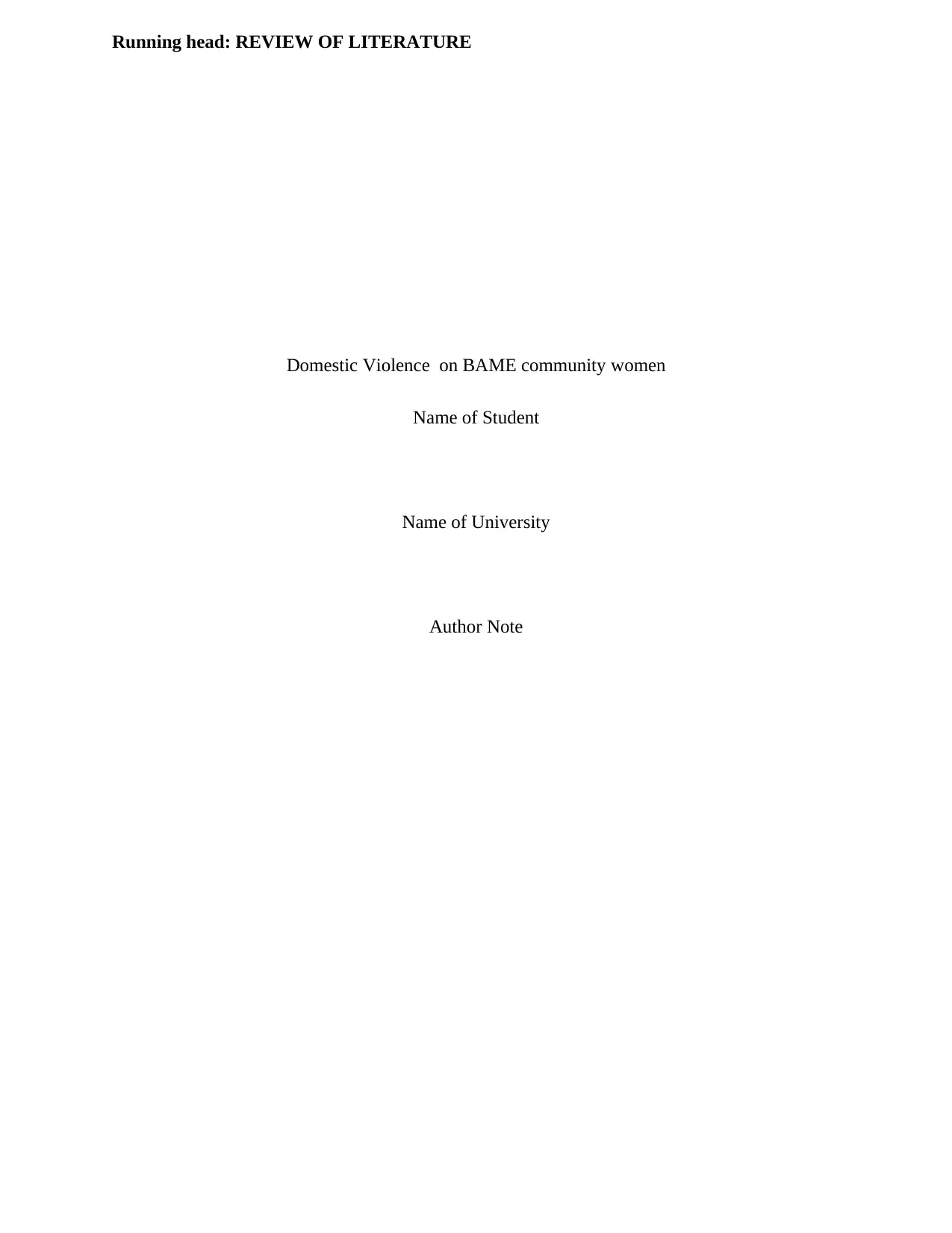
Running head: REVIEW OF LITERATURE
Domestic Violence on BAME community women
Name of Student
Name of University
Author Note
Domestic Violence on BAME community women
Name of Student
Name of University
Author Note
Secure Best Marks with AI Grader
Need help grading? Try our AI Grader for instant feedback on your assignments.
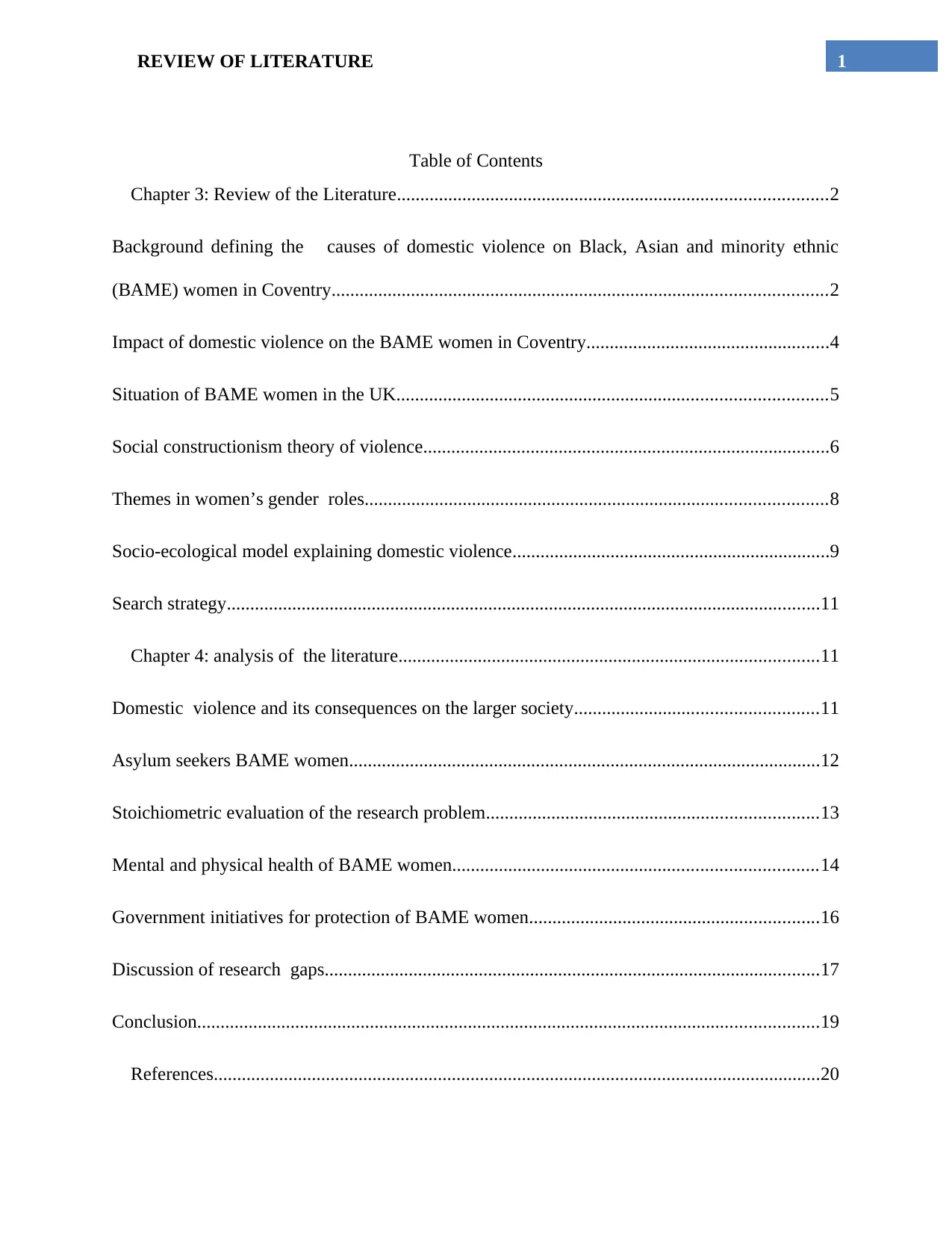
1REVIEW OF LITERATURE
Table of Contents
Chapter 3: Review of the Literature............................................................................................2
Background defining the causes of domestic violence on Black, Asian and minority ethnic
(BAME) women in Coventry..........................................................................................................2
Impact of domestic violence on the BAME women in Coventry....................................................4
Situation of BAME women in the UK............................................................................................5
Social constructionism theory of violence.......................................................................................6
Themes in women’s gender roles...................................................................................................8
Socio-ecological model explaining domestic violence....................................................................9
Search strategy...............................................................................................................................11
Chapter 4: analysis of the literature..........................................................................................11
Domestic violence and its consequences on the larger society....................................................11
Asylum seekers BAME women.....................................................................................................12
Stoichiometric evaluation of the research problem.......................................................................13
Mental and physical health of BAME women..............................................................................14
Government initiatives for protection of BAME women..............................................................16
Discussion of research gaps..........................................................................................................17
Conclusion.....................................................................................................................................19
References..................................................................................................................................20
Table of Contents
Chapter 3: Review of the Literature............................................................................................2
Background defining the causes of domestic violence on Black, Asian and minority ethnic
(BAME) women in Coventry..........................................................................................................2
Impact of domestic violence on the BAME women in Coventry....................................................4
Situation of BAME women in the UK............................................................................................5
Social constructionism theory of violence.......................................................................................6
Themes in women’s gender roles...................................................................................................8
Socio-ecological model explaining domestic violence....................................................................9
Search strategy...............................................................................................................................11
Chapter 4: analysis of the literature..........................................................................................11
Domestic violence and its consequences on the larger society....................................................11
Asylum seekers BAME women.....................................................................................................12
Stoichiometric evaluation of the research problem.......................................................................13
Mental and physical health of BAME women..............................................................................14
Government initiatives for protection of BAME women..............................................................16
Discussion of research gaps..........................................................................................................17
Conclusion.....................................................................................................................................19
References..................................................................................................................................20
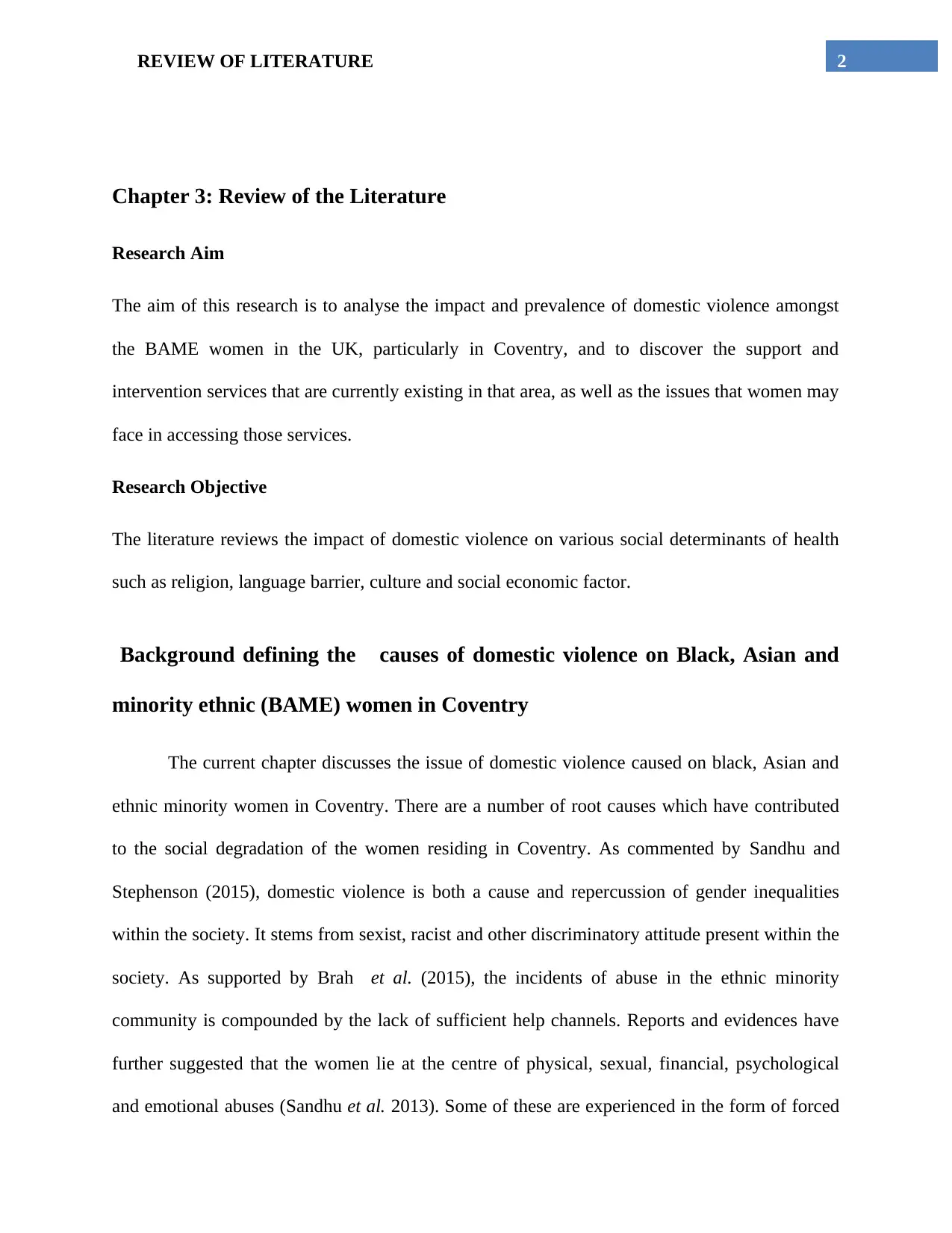
2REVIEW OF LITERATURE
Chapter 3: Review of the Literature
Research Aim
The aim of this research is to analyse the impact and prevalence of domestic violence amongst
the BAME women in the UK, particularly in Coventry, and to discover the support and
intervention services that are currently existing in that area, as well as the issues that women may
face in accessing those services.
Research Objective
The literature reviews the impact of domestic violence on various social determinants of health
such as religion, language barrier, culture and social economic factor.
Background defining the causes of domestic violence on Black, Asian and
minority ethnic (BAME) women in Coventry
The current chapter discusses the issue of domestic violence caused on black, Asian and
ethnic minority women in Coventry. There are a number of root causes which have contributed
to the social degradation of the women residing in Coventry. As commented by Sandhu and
Stephenson (2015), domestic violence is both a cause and repercussion of gender inequalities
within the society. It stems from sexist, racist and other discriminatory attitude present within the
society. As supported by Brah et al. (2015), the incidents of abuse in the ethnic minority
community is compounded by the lack of sufficient help channels. Reports and evidences have
further suggested that the women lie at the centre of physical, sexual, financial, psychological
and emotional abuses (Sandhu et al. 2013). Some of these are experienced in the form of forced
Chapter 3: Review of the Literature
Research Aim
The aim of this research is to analyse the impact and prevalence of domestic violence amongst
the BAME women in the UK, particularly in Coventry, and to discover the support and
intervention services that are currently existing in that area, as well as the issues that women may
face in accessing those services.
Research Objective
The literature reviews the impact of domestic violence on various social determinants of health
such as religion, language barrier, culture and social economic factor.
Background defining the causes of domestic violence on Black, Asian and
minority ethnic (BAME) women in Coventry
The current chapter discusses the issue of domestic violence caused on black, Asian and
ethnic minority women in Coventry. There are a number of root causes which have contributed
to the social degradation of the women residing in Coventry. As commented by Sandhu and
Stephenson (2015), domestic violence is both a cause and repercussion of gender inequalities
within the society. It stems from sexist, racist and other discriminatory attitude present within the
society. As supported by Brah et al. (2015), the incidents of abuse in the ethnic minority
community is compounded by the lack of sufficient help channels. Reports and evidences have
further suggested that the women lie at the centre of physical, sexual, financial, psychological
and emotional abuses (Sandhu et al. 2013). Some of these are experienced in the form of forced

3REVIEW OF LITERATURE
marriage, female genital mutilation and honour based violence. As mentioned by Brah et al.
(2015), culture, language, family structure and racism are few of the factors which have a direct
relation to the abuse faced by the BAME women. One of the root causes for the domestic
violence faced by the BAME women is due to the social inequality present within the
community. The BAME women suffer from disproportionate representation in low paid or
insecure employment. The inequalities could strongly be attributed to the cuts introduced by the
government, which could cost the residents of the Coventry region £112 million per year
(Sandhu et al. 2013). The women in the Coventry region suffer from high unemployment rates
owing to a number of issues such as family, child care, language, community, societal barriers,
racism and discrimination. The BAME women suffer due to lower rates of education suffer from
language issues, which serves a major hindrance for them. This prevents them from
communicating with the concerned channels for help resulting in them being subjected to more
abuses. The culture and community paradoxes also serve as a major hindrance where the some
of the women of Asian origin are restricted with regards to making their job preferences. As
mentioned by (Nightingale and Cromby 2017), women belonging to the black minority and
ethnic group are often discriminated based upon their skin colour. Most of the times, they have to
face societal neglect and disregard owing to their skin colours. Additionally, the lack of stable
and secure jobs makes them more prone to domestic abuses. The cuts on some of the
government features such as education maintenance allowance (EMA) has resulted in higher
education charges, which has lowered the number of higher education enrolments of the BAME
women living in the Coventry region. As mentioned by Brah et al. (2015), the lack of a strong
source of income or a financially stable condition has resulted in many women being subjected
to domestic violence. This is because under these conditions the women are dependable amongst
marriage, female genital mutilation and honour based violence. As mentioned by Brah et al.
(2015), culture, language, family structure and racism are few of the factors which have a direct
relation to the abuse faced by the BAME women. One of the root causes for the domestic
violence faced by the BAME women is due to the social inequality present within the
community. The BAME women suffer from disproportionate representation in low paid or
insecure employment. The inequalities could strongly be attributed to the cuts introduced by the
government, which could cost the residents of the Coventry region £112 million per year
(Sandhu et al. 2013). The women in the Coventry region suffer from high unemployment rates
owing to a number of issues such as family, child care, language, community, societal barriers,
racism and discrimination. The BAME women suffer due to lower rates of education suffer from
language issues, which serves a major hindrance for them. This prevents them from
communicating with the concerned channels for help resulting in them being subjected to more
abuses. The culture and community paradoxes also serve as a major hindrance where the some
of the women of Asian origin are restricted with regards to making their job preferences. As
mentioned by (Nightingale and Cromby 2017), women belonging to the black minority and
ethnic group are often discriminated based upon their skin colour. Most of the times, they have to
face societal neglect and disregard owing to their skin colours. Additionally, the lack of stable
and secure jobs makes them more prone to domestic abuses. The cuts on some of the
government features such as education maintenance allowance (EMA) has resulted in higher
education charges, which has lowered the number of higher education enrolments of the BAME
women living in the Coventry region. As mentioned by Brah et al. (2015), the lack of a strong
source of income or a financially stable condition has resulted in many women being subjected
to domestic violence. This is because under these conditions the women are dependable amongst
Secure Best Marks with AI Grader
Need help grading? Try our AI Grader for instant feedback on your assignments.

4REVIEW OF LITERATURE
the earning member of the family. On the contrary Muehlenhard and Kimes (2014), many ethnic
and minority community women believe that going outside for work may disrupt their family life
and put their children at higher risk of neglect. Reports and evidences have suggested that the
women occasionally have to wait longer for getting enrolled in English for Speakers of other
language (ESOL) courses. Panagarh is the specialist services, which provides support services
for BAME women who have suffered violence and abuse in Coventry lost £300k a year for their
refugee provision to Leicester (Schneider 2016). This had a huge impact upon the staffing and
services available for BAME women living in Coventry. Additionally, Coventry rape and sexual
abuse centre lost funding from the human rights commission, which leads to unsuccessful trial
and prosecution of offenders. Hence, lack of sufficient education and economic facilities can be
stated to be one of the root causes of distress for BAME women residing in Coventry.
Impact of domestic violence on the BAME women in Coventry
A lot of times women play the role of “shock-absorbers” in the family when faced with
crisis. They tend to manage a financial crisis by reducing the amount of supplies from their own
share. The pressure of the family is directly taken out on women by the masculine figures of the
family. This causes the practice of domestic violence as a direct result of budget reductions and
this becomes a norm in the BAME society (Sandhu Stephenson and Harrison 2013). The impact
being reduced health due to physical or mental oppression as well as inability to have access to
proper nutrition. The impact of domestic violence is not only physical injury but also impacts the
mental and physical well being of the BAME community women over long periods of time. The
psychological effects of these violent actions lead to many mental illness like depression, anxiety
and isolation. The result of domestic violence is that it leaves the affected women in a constant
state of fear, makes them prone to night terrors, sleeplessness chronic hypertension, post
the earning member of the family. On the contrary Muehlenhard and Kimes (2014), many ethnic
and minority community women believe that going outside for work may disrupt their family life
and put their children at higher risk of neglect. Reports and evidences have suggested that the
women occasionally have to wait longer for getting enrolled in English for Speakers of other
language (ESOL) courses. Panagarh is the specialist services, which provides support services
for BAME women who have suffered violence and abuse in Coventry lost £300k a year for their
refugee provision to Leicester (Schneider 2016). This had a huge impact upon the staffing and
services available for BAME women living in Coventry. Additionally, Coventry rape and sexual
abuse centre lost funding from the human rights commission, which leads to unsuccessful trial
and prosecution of offenders. Hence, lack of sufficient education and economic facilities can be
stated to be one of the root causes of distress for BAME women residing in Coventry.
Impact of domestic violence on the BAME women in Coventry
A lot of times women play the role of “shock-absorbers” in the family when faced with
crisis. They tend to manage a financial crisis by reducing the amount of supplies from their own
share. The pressure of the family is directly taken out on women by the masculine figures of the
family. This causes the practice of domestic violence as a direct result of budget reductions and
this becomes a norm in the BAME society (Sandhu Stephenson and Harrison 2013). The impact
being reduced health due to physical or mental oppression as well as inability to have access to
proper nutrition. The impact of domestic violence is not only physical injury but also impacts the
mental and physical well being of the BAME community women over long periods of time. The
psychological effects of these violent actions lead to many mental illness like depression, anxiety
and isolation. The result of domestic violence is that it leaves the affected women in a constant
state of fear, makes them prone to night terrors, sleeplessness chronic hypertension, post
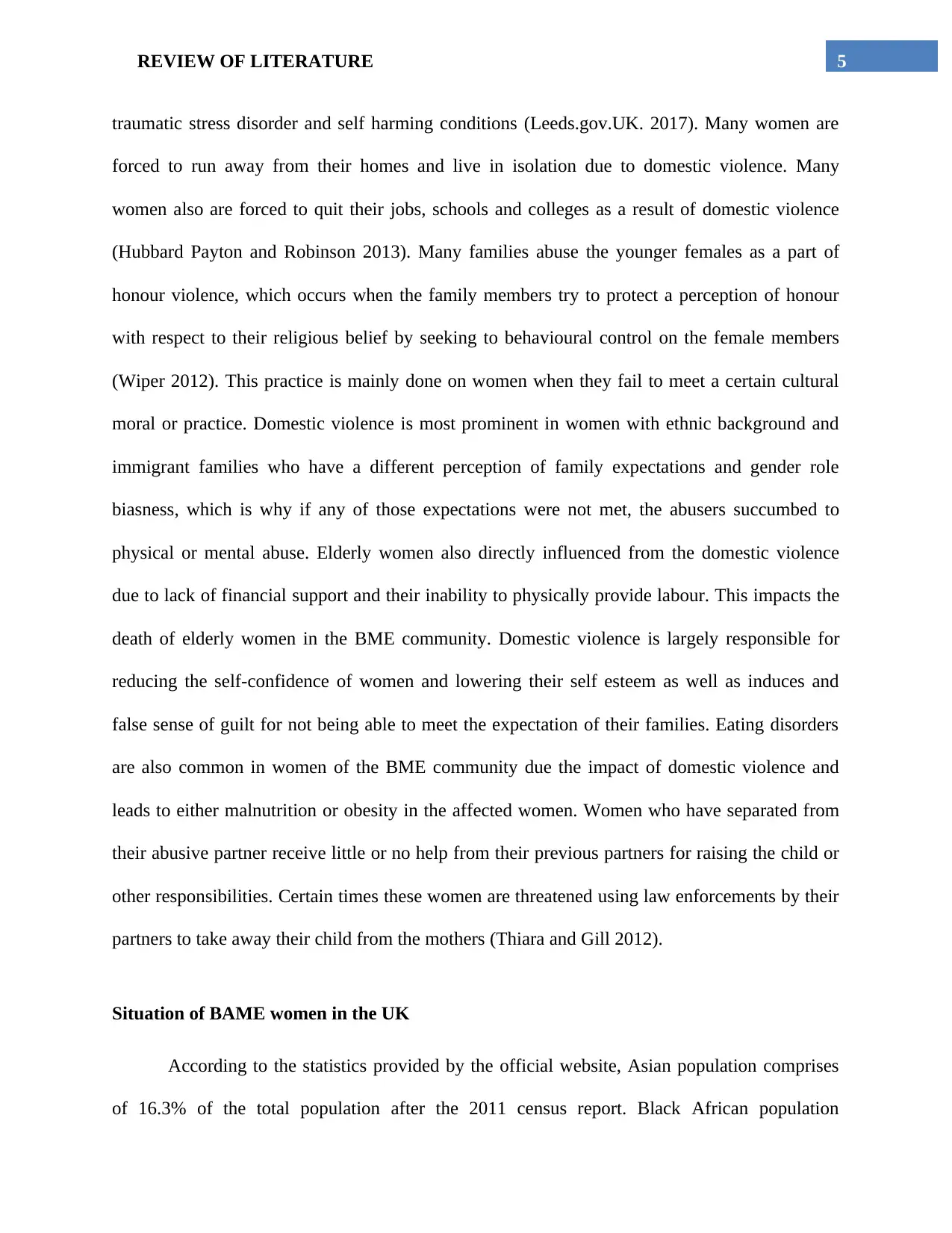
5REVIEW OF LITERATURE
traumatic stress disorder and self harming conditions (Leeds.gov.UK. 2017). Many women are
forced to run away from their homes and live in isolation due to domestic violence. Many
women also are forced to quit their jobs, schools and colleges as a result of domestic violence
(Hubbard Payton and Robinson 2013). Many families abuse the younger females as a part of
honour violence, which occurs when the family members try to protect a perception of honour
with respect to their religious belief by seeking to behavioural control on the female members
(Wiper 2012). This practice is mainly done on women when they fail to meet a certain cultural
moral or practice. Domestic violence is most prominent in women with ethnic background and
immigrant families who have a different perception of family expectations and gender role
biasness, which is why if any of those expectations were not met, the abusers succumbed to
physical or mental abuse. Elderly women also directly influenced from the domestic violence
due to lack of financial support and their inability to physically provide labour. This impacts the
death of elderly women in the BME community. Domestic violence is largely responsible for
reducing the self-confidence of women and lowering their self esteem as well as induces and
false sense of guilt for not being able to meet the expectation of their families. Eating disorders
are also common in women of the BME community due the impact of domestic violence and
leads to either malnutrition or obesity in the affected women. Women who have separated from
their abusive partner receive little or no help from their previous partners for raising the child or
other responsibilities. Certain times these women are threatened using law enforcements by their
partners to take away their child from the mothers (Thiara and Gill 2012).
Situation of BAME women in the UK
According to the statistics provided by the official website, Asian population comprises
of 16.3% of the total population after the 2011 census report. Black African population
traumatic stress disorder and self harming conditions (Leeds.gov.UK. 2017). Many women are
forced to run away from their homes and live in isolation due to domestic violence. Many
women also are forced to quit their jobs, schools and colleges as a result of domestic violence
(Hubbard Payton and Robinson 2013). Many families abuse the younger females as a part of
honour violence, which occurs when the family members try to protect a perception of honour
with respect to their religious belief by seeking to behavioural control on the female members
(Wiper 2012). This practice is mainly done on women when they fail to meet a certain cultural
moral or practice. Domestic violence is most prominent in women with ethnic background and
immigrant families who have a different perception of family expectations and gender role
biasness, which is why if any of those expectations were not met, the abusers succumbed to
physical or mental abuse. Elderly women also directly influenced from the domestic violence
due to lack of financial support and their inability to physically provide labour. This impacts the
death of elderly women in the BME community. Domestic violence is largely responsible for
reducing the self-confidence of women and lowering their self esteem as well as induces and
false sense of guilt for not being able to meet the expectation of their families. Eating disorders
are also common in women of the BME community due the impact of domestic violence and
leads to either malnutrition or obesity in the affected women. Women who have separated from
their abusive partner receive little or no help from their previous partners for raising the child or
other responsibilities. Certain times these women are threatened using law enforcements by their
partners to take away their child from the mothers (Thiara and Gill 2012).
Situation of BAME women in the UK
According to the statistics provided by the official website, Asian population comprises
of 16.3% of the total population after the 2011 census report. Black African population
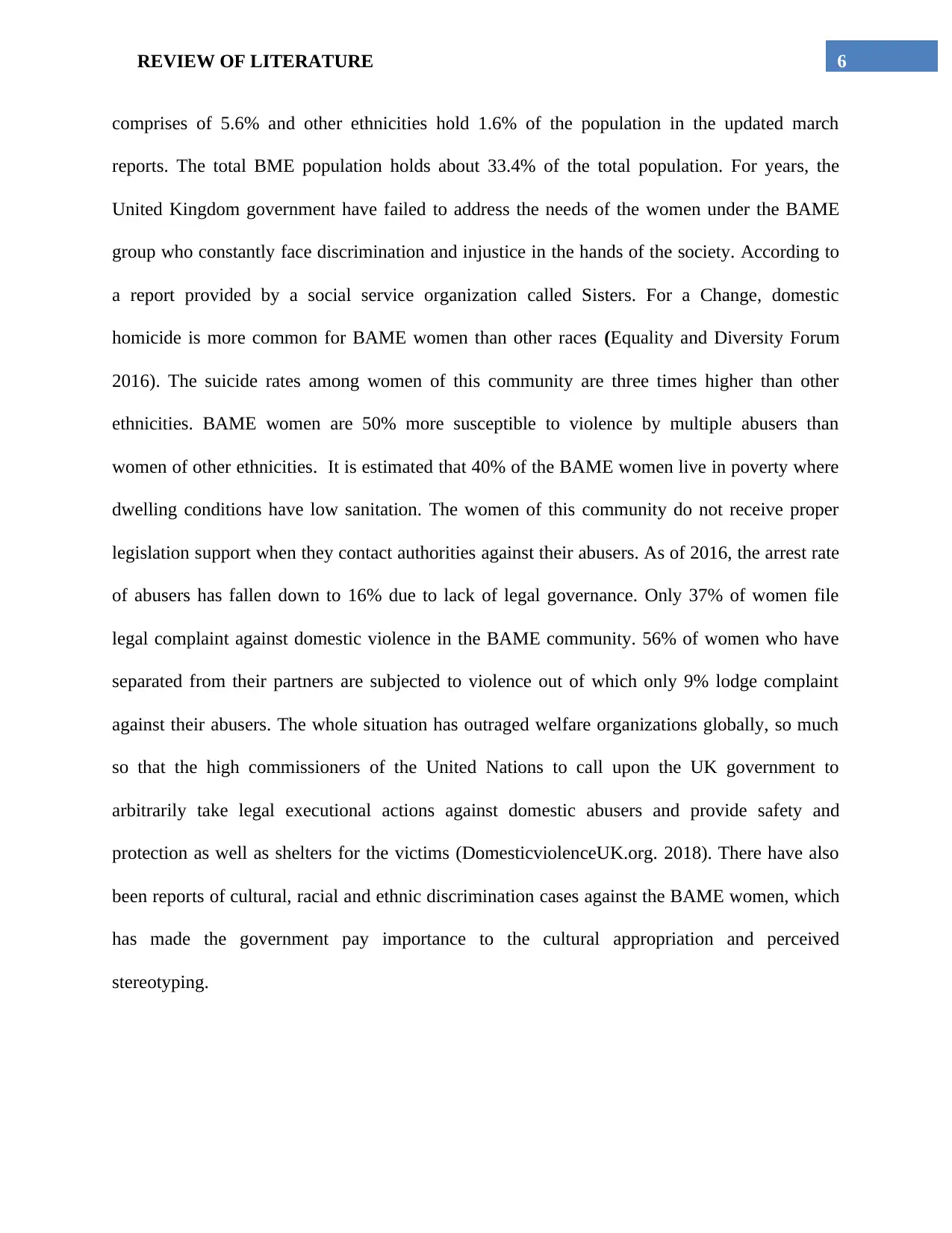
6REVIEW OF LITERATURE
comprises of 5.6% and other ethnicities hold 1.6% of the population in the updated march
reports. The total BME population holds about 33.4% of the total population. For years, the
United Kingdom government have failed to address the needs of the women under the BAME
group who constantly face discrimination and injustice in the hands of the society. According to
a report provided by a social service organization called Sisters. For a Change, domestic
homicide is more common for BAME women than other races (Equality and Diversity Forum
2016). The suicide rates among women of this community are three times higher than other
ethnicities. BAME women are 50% more susceptible to violence by multiple abusers than
women of other ethnicities. It is estimated that 40% of the BAME women live in poverty where
dwelling conditions have low sanitation. The women of this community do not receive proper
legislation support when they contact authorities against their abusers. As of 2016, the arrest rate
of abusers has fallen down to 16% due to lack of legal governance. Only 37% of women file
legal complaint against domestic violence in the BAME community. 56% of women who have
separated from their partners are subjected to violence out of which only 9% lodge complaint
against their abusers. The whole situation has outraged welfare organizations globally, so much
so that the high commissioners of the United Nations to call upon the UK government to
arbitrarily take legal executional actions against domestic abusers and provide safety and
protection as well as shelters for the victims (DomesticviolenceUK.org. 2018). There have also
been reports of cultural, racial and ethnic discrimination cases against the BAME women, which
has made the government pay importance to the cultural appropriation and perceived
stereotyping.
comprises of 5.6% and other ethnicities hold 1.6% of the population in the updated march
reports. The total BME population holds about 33.4% of the total population. For years, the
United Kingdom government have failed to address the needs of the women under the BAME
group who constantly face discrimination and injustice in the hands of the society. According to
a report provided by a social service organization called Sisters. For a Change, domestic
homicide is more common for BAME women than other races (Equality and Diversity Forum
2016). The suicide rates among women of this community are three times higher than other
ethnicities. BAME women are 50% more susceptible to violence by multiple abusers than
women of other ethnicities. It is estimated that 40% of the BAME women live in poverty where
dwelling conditions have low sanitation. The women of this community do not receive proper
legislation support when they contact authorities against their abusers. As of 2016, the arrest rate
of abusers has fallen down to 16% due to lack of legal governance. Only 37% of women file
legal complaint against domestic violence in the BAME community. 56% of women who have
separated from their partners are subjected to violence out of which only 9% lodge complaint
against their abusers. The whole situation has outraged welfare organizations globally, so much
so that the high commissioners of the United Nations to call upon the UK government to
arbitrarily take legal executional actions against domestic abusers and provide safety and
protection as well as shelters for the victims (DomesticviolenceUK.org. 2018). There have also
been reports of cultural, racial and ethnic discrimination cases against the BAME women, which
has made the government pay importance to the cultural appropriation and perceived
stereotyping.
Paraphrase This Document
Need a fresh take? Get an instant paraphrase of this document with our AI Paraphraser
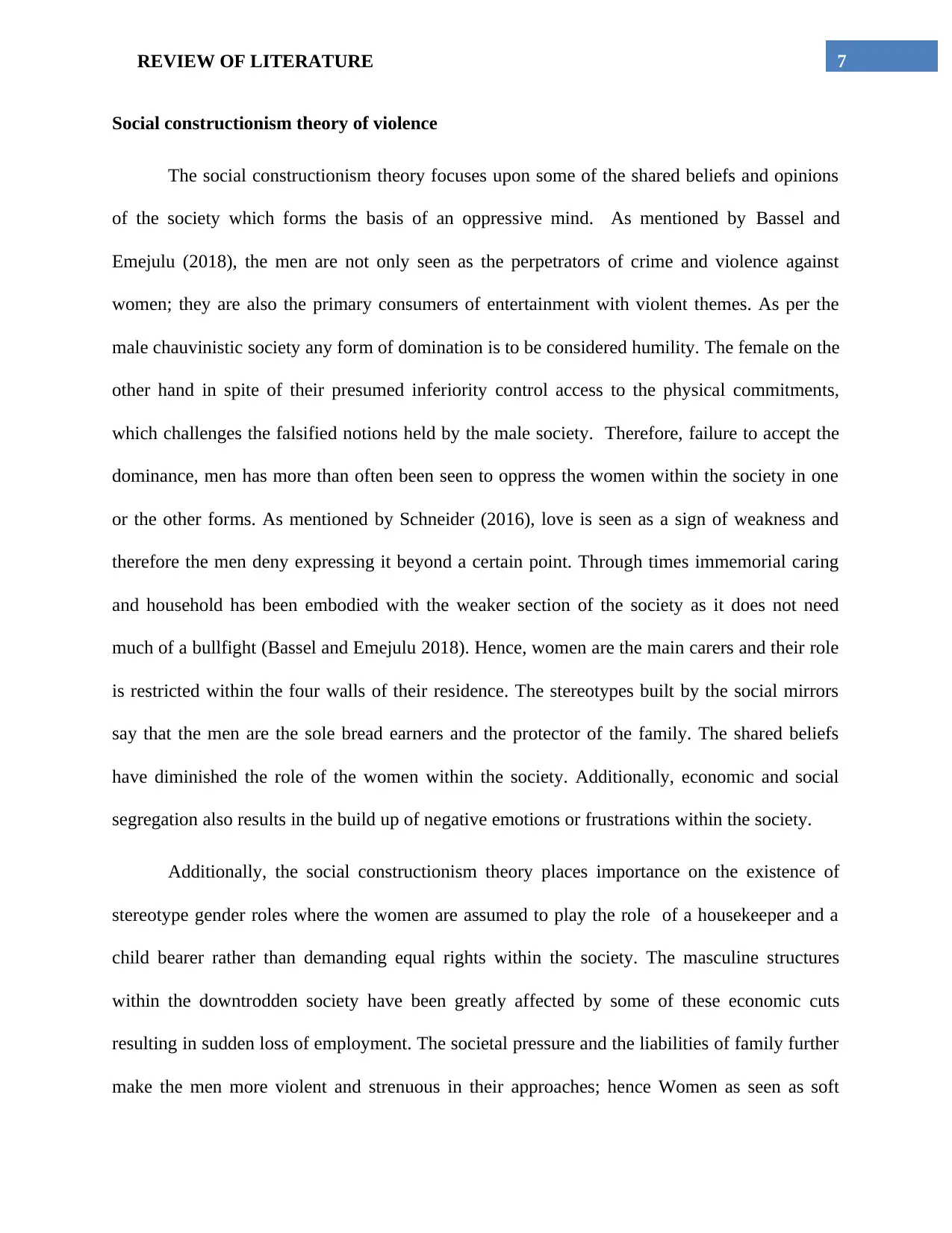
7REVIEW OF LITERATURE
Social constructionism theory of violence
The social constructionism theory focuses upon some of the shared beliefs and opinions
of the society which forms the basis of an oppressive mind. As mentioned by Bassel and
Emejulu (2018), the men are not only seen as the perpetrators of crime and violence against
women; they are also the primary consumers of entertainment with violent themes. As per the
male chauvinistic society any form of domination is to be considered humility. The female on the
other hand in spite of their presumed inferiority control access to the physical commitments,
which challenges the falsified notions held by the male society. Therefore, failure to accept the
dominance, men has more than often been seen to oppress the women within the society in one
or the other forms. As mentioned by Schneider (2016), love is seen as a sign of weakness and
therefore the men deny expressing it beyond a certain point. Through times immemorial caring
and household has been embodied with the weaker section of the society as it does not need
much of a bullfight (Bassel and Emejulu 2018). Hence, women are the main carers and their role
is restricted within the four walls of their residence. The stereotypes built by the social mirrors
say that the men are the sole bread earners and the protector of the family. The shared beliefs
have diminished the role of the women within the society. Additionally, economic and social
segregation also results in the build up of negative emotions or frustrations within the society.
Additionally, the social constructionism theory places importance on the existence of
stereotype gender roles where the women are assumed to play the role of a housekeeper and a
child bearer rather than demanding equal rights within the society. The masculine structures
within the downtrodden society have been greatly affected by some of these economic cuts
resulting in sudden loss of employment. The societal pressure and the liabilities of family further
make the men more violent and strenuous in their approaches; hence Women as seen as soft
Social constructionism theory of violence
The social constructionism theory focuses upon some of the shared beliefs and opinions
of the society which forms the basis of an oppressive mind. As mentioned by Bassel and
Emejulu (2018), the men are not only seen as the perpetrators of crime and violence against
women; they are also the primary consumers of entertainment with violent themes. As per the
male chauvinistic society any form of domination is to be considered humility. The female on the
other hand in spite of their presumed inferiority control access to the physical commitments,
which challenges the falsified notions held by the male society. Therefore, failure to accept the
dominance, men has more than often been seen to oppress the women within the society in one
or the other forms. As mentioned by Schneider (2016), love is seen as a sign of weakness and
therefore the men deny expressing it beyond a certain point. Through times immemorial caring
and household has been embodied with the weaker section of the society as it does not need
much of a bullfight (Bassel and Emejulu 2018). Hence, women are the main carers and their role
is restricted within the four walls of their residence. The stereotypes built by the social mirrors
say that the men are the sole bread earners and the protector of the family. The shared beliefs
have diminished the role of the women within the society. Additionally, economic and social
segregation also results in the build up of negative emotions or frustrations within the society.
Additionally, the social constructionism theory places importance on the existence of
stereotype gender roles where the women are assumed to play the role of a housekeeper and a
child bearer rather than demanding equal rights within the society. The masculine structures
within the downtrodden society have been greatly affected by some of these economic cuts
resulting in sudden loss of employment. The societal pressure and the liabilities of family further
make the men more violent and strenuous in their approaches; hence Women as seen as soft
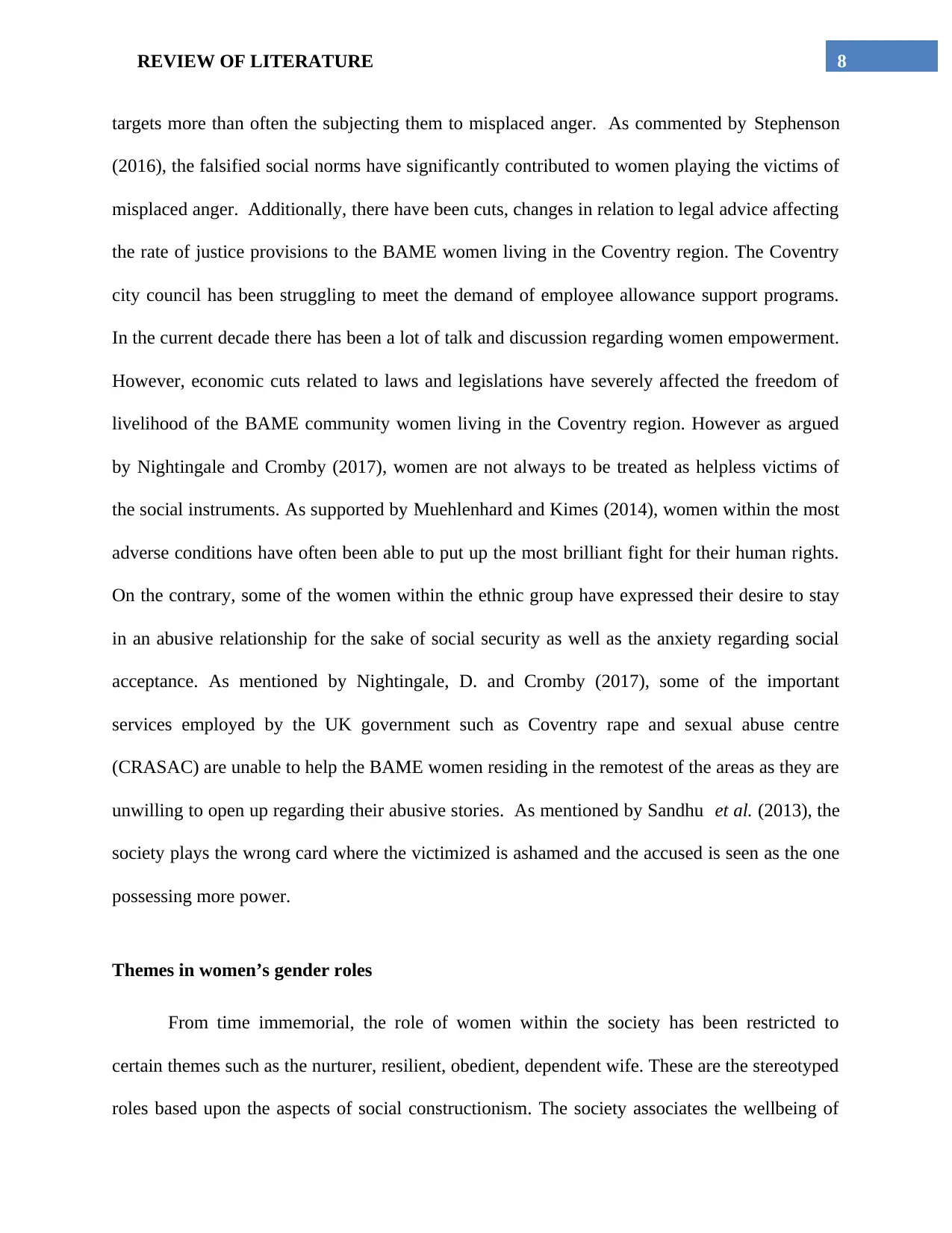
8REVIEW OF LITERATURE
targets more than often the subjecting them to misplaced anger. As commented by Stephenson
(2016), the falsified social norms have significantly contributed to women playing the victims of
misplaced anger. Additionally, there have been cuts, changes in relation to legal advice affecting
the rate of justice provisions to the BAME women living in the Coventry region. The Coventry
city council has been struggling to meet the demand of employee allowance support programs.
In the current decade there has been a lot of talk and discussion regarding women empowerment.
However, economic cuts related to laws and legislations have severely affected the freedom of
livelihood of the BAME community women living in the Coventry region. However as argued
by Nightingale and Cromby (2017), women are not always to be treated as helpless victims of
the social instruments. As supported by Muehlenhard and Kimes (2014), women within the most
adverse conditions have often been able to put up the most brilliant fight for their human rights.
On the contrary, some of the women within the ethnic group have expressed their desire to stay
in an abusive relationship for the sake of social security as well as the anxiety regarding social
acceptance. As mentioned by Nightingale, D. and Cromby (2017), some of the important
services employed by the UK government such as Coventry rape and sexual abuse centre
(CRASAC) are unable to help the BAME women residing in the remotest of the areas as they are
unwilling to open up regarding their abusive stories. As mentioned by Sandhu et al. (2013), the
society plays the wrong card where the victimized is ashamed and the accused is seen as the one
possessing more power.
Themes in women’s gender roles
From time immemorial, the role of women within the society has been restricted to
certain themes such as the nurturer, resilient, obedient, dependent wife. These are the stereotyped
roles based upon the aspects of social constructionism. The society associates the wellbeing of
targets more than often the subjecting them to misplaced anger. As commented by Stephenson
(2016), the falsified social norms have significantly contributed to women playing the victims of
misplaced anger. Additionally, there have been cuts, changes in relation to legal advice affecting
the rate of justice provisions to the BAME women living in the Coventry region. The Coventry
city council has been struggling to meet the demand of employee allowance support programs.
In the current decade there has been a lot of talk and discussion regarding women empowerment.
However, economic cuts related to laws and legislations have severely affected the freedom of
livelihood of the BAME community women living in the Coventry region. However as argued
by Nightingale and Cromby (2017), women are not always to be treated as helpless victims of
the social instruments. As supported by Muehlenhard and Kimes (2014), women within the most
adverse conditions have often been able to put up the most brilliant fight for their human rights.
On the contrary, some of the women within the ethnic group have expressed their desire to stay
in an abusive relationship for the sake of social security as well as the anxiety regarding social
acceptance. As mentioned by Nightingale, D. and Cromby (2017), some of the important
services employed by the UK government such as Coventry rape and sexual abuse centre
(CRASAC) are unable to help the BAME women residing in the remotest of the areas as they are
unwilling to open up regarding their abusive stories. As mentioned by Sandhu et al. (2013), the
society plays the wrong card where the victimized is ashamed and the accused is seen as the one
possessing more power.
Themes in women’s gender roles
From time immemorial, the role of women within the society has been restricted to
certain themes such as the nurturer, resilient, obedient, dependent wife. These are the stereotyped
roles based upon the aspects of social constructionism. The society associates the wellbeing of

9REVIEW OF LITERATURE
the children as the sheer responsibility of the mother. As mentioned by Muehlenhard and Kimes
(2014), the children are thought to be explicitly connected to the mother. Therefore, inflicting
harm upon the children could also force the mother to comply with the unjust behaviour of their
male partners. The BAME women are often restricted to making their career choices owing
family liabilities and the responsibilities of children. The societal norms have further enforced
the aspect of resilience within the women. However as argued by Bassel and Emejulu (2018),
there are marked differences between the approaches of women in the eastern and western
community. In the western countries, some of the women have been seen to raise strong voices
against the oppression imposed upon them by their male partners. However, as argued by
Frankenburg (2012), women within the Asian community have been seen to be reluctant in
raising their voices against the abuses imposed upon them by their male partners. Some of these
have been justified by strong community beliefs and paradoxes, which restricts the women from
approaching the justice channels. As commented by Best (2017), the women have been afraid to
approach the right justice channels due to the fear of social rejection. Some of the BAME
community women have been overly dependent upon the male members of the family for money
and social security and attributes themselves entitled to the services of the family owing to the
monetary security, which they are getting from their families. Therefore, resilience has been
associated with liabilities in this case.
The roles of the BAME Coventry women have been cut down by a number of social
instruments such as restricted housing, educational and employment opportunities. Therefore, the
women have little or no social roles to play and are confined to the fine geometry of their homes.
Reports and evidenced have suggested that most of the ethnic minority communities live in
deprived areas with poor living conditions and large families. Therefore, the sole responsibility
the children as the sheer responsibility of the mother. As mentioned by Muehlenhard and Kimes
(2014), the children are thought to be explicitly connected to the mother. Therefore, inflicting
harm upon the children could also force the mother to comply with the unjust behaviour of their
male partners. The BAME women are often restricted to making their career choices owing
family liabilities and the responsibilities of children. The societal norms have further enforced
the aspect of resilience within the women. However as argued by Bassel and Emejulu (2018),
there are marked differences between the approaches of women in the eastern and western
community. In the western countries, some of the women have been seen to raise strong voices
against the oppression imposed upon them by their male partners. However, as argued by
Frankenburg (2012), women within the Asian community have been seen to be reluctant in
raising their voices against the abuses imposed upon them by their male partners. Some of these
have been justified by strong community beliefs and paradoxes, which restricts the women from
approaching the justice channels. As commented by Best (2017), the women have been afraid to
approach the right justice channels due to the fear of social rejection. Some of the BAME
community women have been overly dependent upon the male members of the family for money
and social security and attributes themselves entitled to the services of the family owing to the
monetary security, which they are getting from their families. Therefore, resilience has been
associated with liabilities in this case.
The roles of the BAME Coventry women have been cut down by a number of social
instruments such as restricted housing, educational and employment opportunities. Therefore, the
women have little or no social roles to play and are confined to the fine geometry of their homes.
Reports and evidenced have suggested that most of the ethnic minority communities live in
deprived areas with poor living conditions and large families. Therefore, the sole responsibility
Secure Best Marks with AI Grader
Need help grading? Try our AI Grader for instant feedback on your assignments.
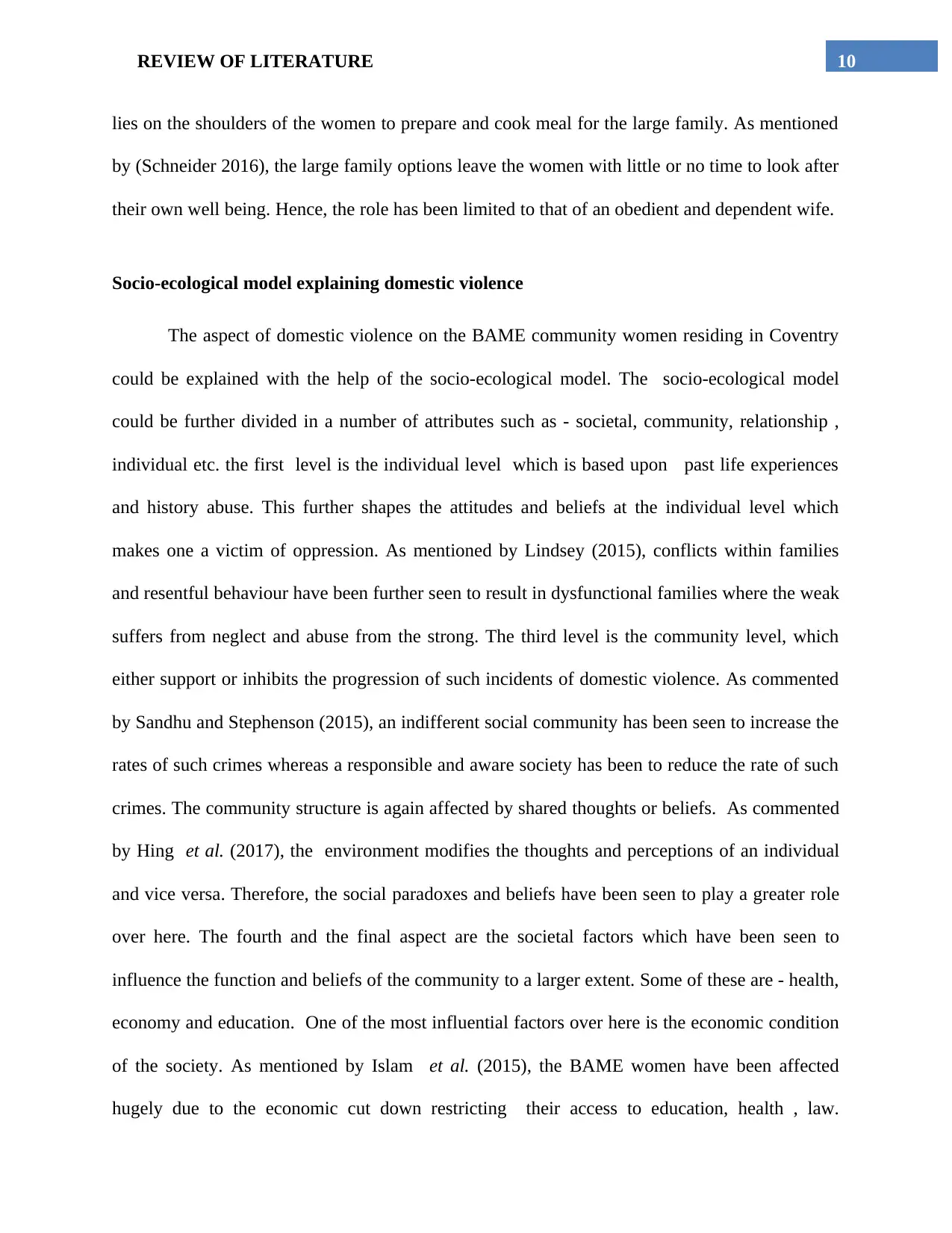
10REVIEW OF LITERATURE
lies on the shoulders of the women to prepare and cook meal for the large family. As mentioned
by (Schneider 2016), the large family options leave the women with little or no time to look after
their own well being. Hence, the role has been limited to that of an obedient and dependent wife.
Socio-ecological model explaining domestic violence
The aspect of domestic violence on the BAME community women residing in Coventry
could be explained with the help of the socio-ecological model. The socio-ecological model
could be further divided in a number of attributes such as - societal, community, relationship ,
individual etc. the first level is the individual level which is based upon past life experiences
and history abuse. This further shapes the attitudes and beliefs at the individual level which
makes one a victim of oppression. As mentioned by Lindsey (2015), conflicts within families
and resentful behaviour have been further seen to result in dysfunctional families where the weak
suffers from neglect and abuse from the strong. The third level is the community level, which
either support or inhibits the progression of such incidents of domestic violence. As commented
by Sandhu and Stephenson (2015), an indifferent social community has been seen to increase the
rates of such crimes whereas a responsible and aware society has been to reduce the rate of such
crimes. The community structure is again affected by shared thoughts or beliefs. As commented
by Hing et al. (2017), the environment modifies the thoughts and perceptions of an individual
and vice versa. Therefore, the social paradoxes and beliefs have been seen to play a greater role
over here. The fourth and the final aspect are the societal factors which have been seen to
influence the function and beliefs of the community to a larger extent. Some of these are - health,
economy and education. One of the most influential factors over here is the economic condition
of the society. As mentioned by Islam et al. (2015), the BAME women have been affected
hugely due to the economic cut down restricting their access to education, health , law.
lies on the shoulders of the women to prepare and cook meal for the large family. As mentioned
by (Schneider 2016), the large family options leave the women with little or no time to look after
their own well being. Hence, the role has been limited to that of an obedient and dependent wife.
Socio-ecological model explaining domestic violence
The aspect of domestic violence on the BAME community women residing in Coventry
could be explained with the help of the socio-ecological model. The socio-ecological model
could be further divided in a number of attributes such as - societal, community, relationship ,
individual etc. the first level is the individual level which is based upon past life experiences
and history abuse. This further shapes the attitudes and beliefs at the individual level which
makes one a victim of oppression. As mentioned by Lindsey (2015), conflicts within families
and resentful behaviour have been further seen to result in dysfunctional families where the weak
suffers from neglect and abuse from the strong. The third level is the community level, which
either support or inhibits the progression of such incidents of domestic violence. As commented
by Sandhu and Stephenson (2015), an indifferent social community has been seen to increase the
rates of such crimes whereas a responsible and aware society has been to reduce the rate of such
crimes. The community structure is again affected by shared thoughts or beliefs. As commented
by Hing et al. (2017), the environment modifies the thoughts and perceptions of an individual
and vice versa. Therefore, the social paradoxes and beliefs have been seen to play a greater role
over here. The fourth and the final aspect are the societal factors which have been seen to
influence the function and beliefs of the community to a larger extent. Some of these are - health,
economy and education. One of the most influential factors over here is the economic condition
of the society. As mentioned by Islam et al. (2015), the BAME women have been affected
hugely due to the economic cut down restricting their access to education, health , law.
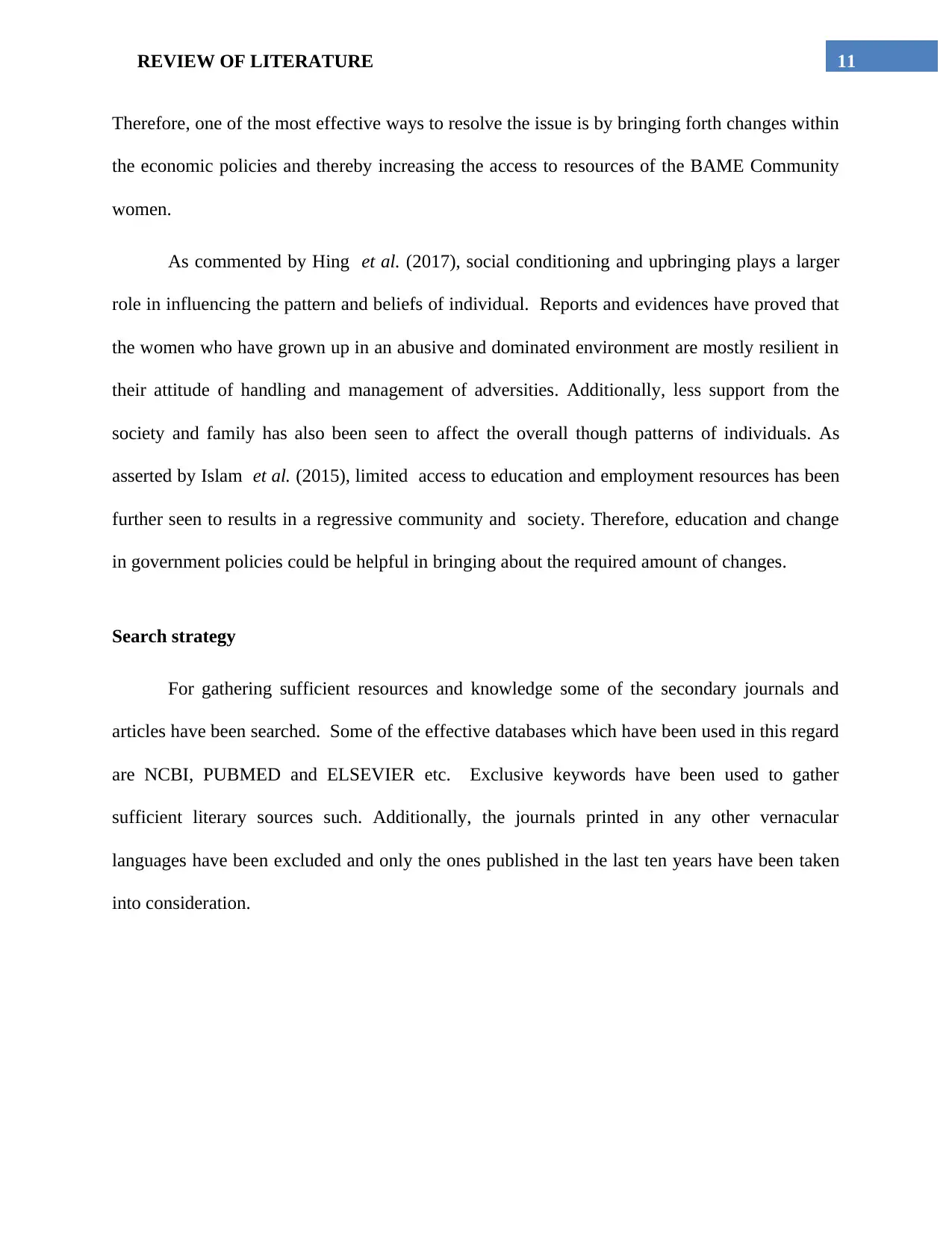
11REVIEW OF LITERATURE
Therefore, one of the most effective ways to resolve the issue is by bringing forth changes within
the economic policies and thereby increasing the access to resources of the BAME Community
women.
As commented by Hing et al. (2017), social conditioning and upbringing plays a larger
role in influencing the pattern and beliefs of individual. Reports and evidences have proved that
the women who have grown up in an abusive and dominated environment are mostly resilient in
their attitude of handling and management of adversities. Additionally, less support from the
society and family has also been seen to affect the overall though patterns of individuals. As
asserted by Islam et al. (2015), limited access to education and employment resources has been
further seen to results in a regressive community and society. Therefore, education and change
in government policies could be helpful in bringing about the required amount of changes.
Search strategy
For gathering sufficient resources and knowledge some of the secondary journals and
articles have been searched. Some of the effective databases which have been used in this regard
are NCBI, PUBMED and ELSEVIER etc. Exclusive keywords have been used to gather
sufficient literary sources such. Additionally, the journals printed in any other vernacular
languages have been excluded and only the ones published in the last ten years have been taken
into consideration.
Therefore, one of the most effective ways to resolve the issue is by bringing forth changes within
the economic policies and thereby increasing the access to resources of the BAME Community
women.
As commented by Hing et al. (2017), social conditioning and upbringing plays a larger
role in influencing the pattern and beliefs of individual. Reports and evidences have proved that
the women who have grown up in an abusive and dominated environment are mostly resilient in
their attitude of handling and management of adversities. Additionally, less support from the
society and family has also been seen to affect the overall though patterns of individuals. As
asserted by Islam et al. (2015), limited access to education and employment resources has been
further seen to results in a regressive community and society. Therefore, education and change
in government policies could be helpful in bringing about the required amount of changes.
Search strategy
For gathering sufficient resources and knowledge some of the secondary journals and
articles have been searched. Some of the effective databases which have been used in this regard
are NCBI, PUBMED and ELSEVIER etc. Exclusive keywords have been used to gather
sufficient literary sources such. Additionally, the journals printed in any other vernacular
languages have been excluded and only the ones published in the last ten years have been taken
into consideration.
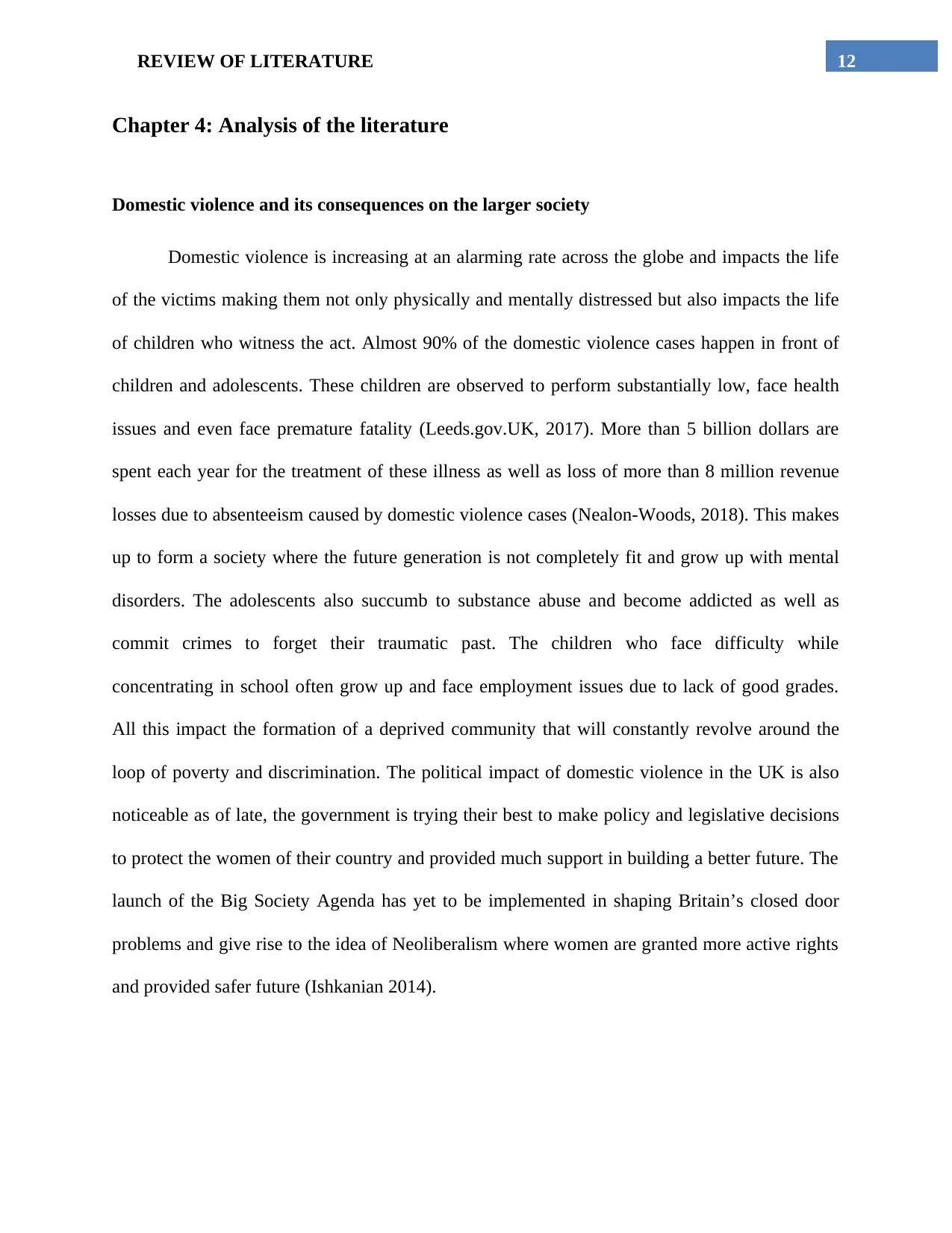
12REVIEW OF LITERATURE
Chapter 4: Analysis of the literature
Domestic violence and its consequences on the larger society
Domestic violence is increasing at an alarming rate across the globe and impacts the life
of the victims making them not only physically and mentally distressed but also impacts the life
of children who witness the act. Almost 90% of the domestic violence cases happen in front of
children and adolescents. These children are observed to perform substantially low, face health
issues and even face premature fatality (Leeds.gov.UK, 2017). More than 5 billion dollars are
spent each year for the treatment of these illness as well as loss of more than 8 million revenue
losses due to absenteeism caused by domestic violence cases (Nealon-Woods, 2018). This makes
up to form a society where the future generation is not completely fit and grow up with mental
disorders. The adolescents also succumb to substance abuse and become addicted as well as
commit crimes to forget their traumatic past. The children who face difficulty while
concentrating in school often grow up and face employment issues due to lack of good grades.
All this impact the formation of a deprived community that will constantly revolve around the
loop of poverty and discrimination. The political impact of domestic violence in the UK is also
noticeable as of late, the government is trying their best to make policy and legislative decisions
to protect the women of their country and provided much support in building a better future. The
launch of the Big Society Agenda has yet to be implemented in shaping Britain’s closed door
problems and give rise to the idea of Neoliberalism where women are granted more active rights
and provided safer future (Ishkanian 2014).
Chapter 4: Analysis of the literature
Domestic violence and its consequences on the larger society
Domestic violence is increasing at an alarming rate across the globe and impacts the life
of the victims making them not only physically and mentally distressed but also impacts the life
of children who witness the act. Almost 90% of the domestic violence cases happen in front of
children and adolescents. These children are observed to perform substantially low, face health
issues and even face premature fatality (Leeds.gov.UK, 2017). More than 5 billion dollars are
spent each year for the treatment of these illness as well as loss of more than 8 million revenue
losses due to absenteeism caused by domestic violence cases (Nealon-Woods, 2018). This makes
up to form a society where the future generation is not completely fit and grow up with mental
disorders. The adolescents also succumb to substance abuse and become addicted as well as
commit crimes to forget their traumatic past. The children who face difficulty while
concentrating in school often grow up and face employment issues due to lack of good grades.
All this impact the formation of a deprived community that will constantly revolve around the
loop of poverty and discrimination. The political impact of domestic violence in the UK is also
noticeable as of late, the government is trying their best to make policy and legislative decisions
to protect the women of their country and provided much support in building a better future. The
launch of the Big Society Agenda has yet to be implemented in shaping Britain’s closed door
problems and give rise to the idea of Neoliberalism where women are granted more active rights
and provided safer future (Ishkanian 2014).
Paraphrase This Document
Need a fresh take? Get an instant paraphrase of this document with our AI Paraphraser
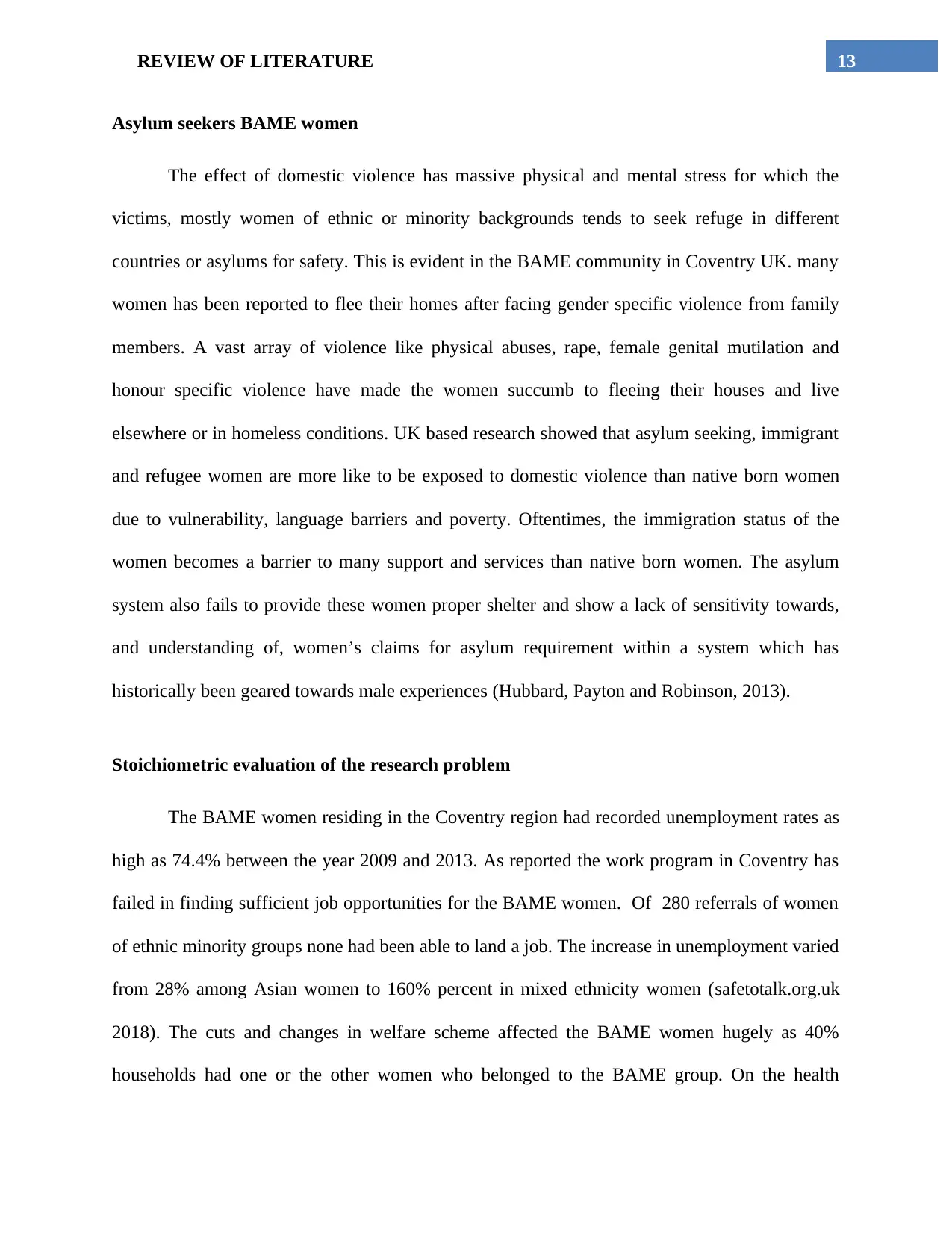
13REVIEW OF LITERATURE
Asylum seekers BAME women
The effect of domestic violence has massive physical and mental stress for which the
victims, mostly women of ethnic or minority backgrounds tends to seek refuge in different
countries or asylums for safety. This is evident in the BAME community in Coventry UK. many
women has been reported to flee their homes after facing gender specific violence from family
members. A vast array of violence like physical abuses, rape, female genital mutilation and
honour specific violence have made the women succumb to fleeing their houses and live
elsewhere or in homeless conditions. UK based research showed that asylum seeking, immigrant
and refugee women are more like to be exposed to domestic violence than native born women
due to vulnerability, language barriers and poverty. Oftentimes, the immigration status of the
women becomes a barrier to many support and services than native born women. The asylum
system also fails to provide these women proper shelter and show a lack of sensitivity towards,
and understanding of, women’s claims for asylum requirement within a system which has
historically been geared towards male experiences (Hubbard, Payton and Robinson, 2013).
Stoichiometric evaluation of the research problem
The BAME women residing in the Coventry region had recorded unemployment rates as
high as 74.4% between the year 2009 and 2013. As reported the work program in Coventry has
failed in finding sufficient job opportunities for the BAME women. Of 280 referrals of women
of ethnic minority groups none had been able to land a job. The increase in unemployment varied
from 28% among Asian women to 160% percent in mixed ethnicity women (safetotalk.org.uk
2018). The cuts and changes in welfare scheme affected the BAME women hugely as 40%
households had one or the other women who belonged to the BAME group. On the health
Asylum seekers BAME women
The effect of domestic violence has massive physical and mental stress for which the
victims, mostly women of ethnic or minority backgrounds tends to seek refuge in different
countries or asylums for safety. This is evident in the BAME community in Coventry UK. many
women has been reported to flee their homes after facing gender specific violence from family
members. A vast array of violence like physical abuses, rape, female genital mutilation and
honour specific violence have made the women succumb to fleeing their houses and live
elsewhere or in homeless conditions. UK based research showed that asylum seeking, immigrant
and refugee women are more like to be exposed to domestic violence than native born women
due to vulnerability, language barriers and poverty. Oftentimes, the immigration status of the
women becomes a barrier to many support and services than native born women. The asylum
system also fails to provide these women proper shelter and show a lack of sensitivity towards,
and understanding of, women’s claims for asylum requirement within a system which has
historically been geared towards male experiences (Hubbard, Payton and Robinson, 2013).
Stoichiometric evaluation of the research problem
The BAME women residing in the Coventry region had recorded unemployment rates as
high as 74.4% between the year 2009 and 2013. As reported the work program in Coventry has
failed in finding sufficient job opportunities for the BAME women. Of 280 referrals of women
of ethnic minority groups none had been able to land a job. The increase in unemployment varied
from 28% among Asian women to 160% percent in mixed ethnicity women (safetotalk.org.uk
2018). The cuts and changes in welfare scheme affected the BAME women hugely as 40%
households had one or the other women who belonged to the BAME group. On the health
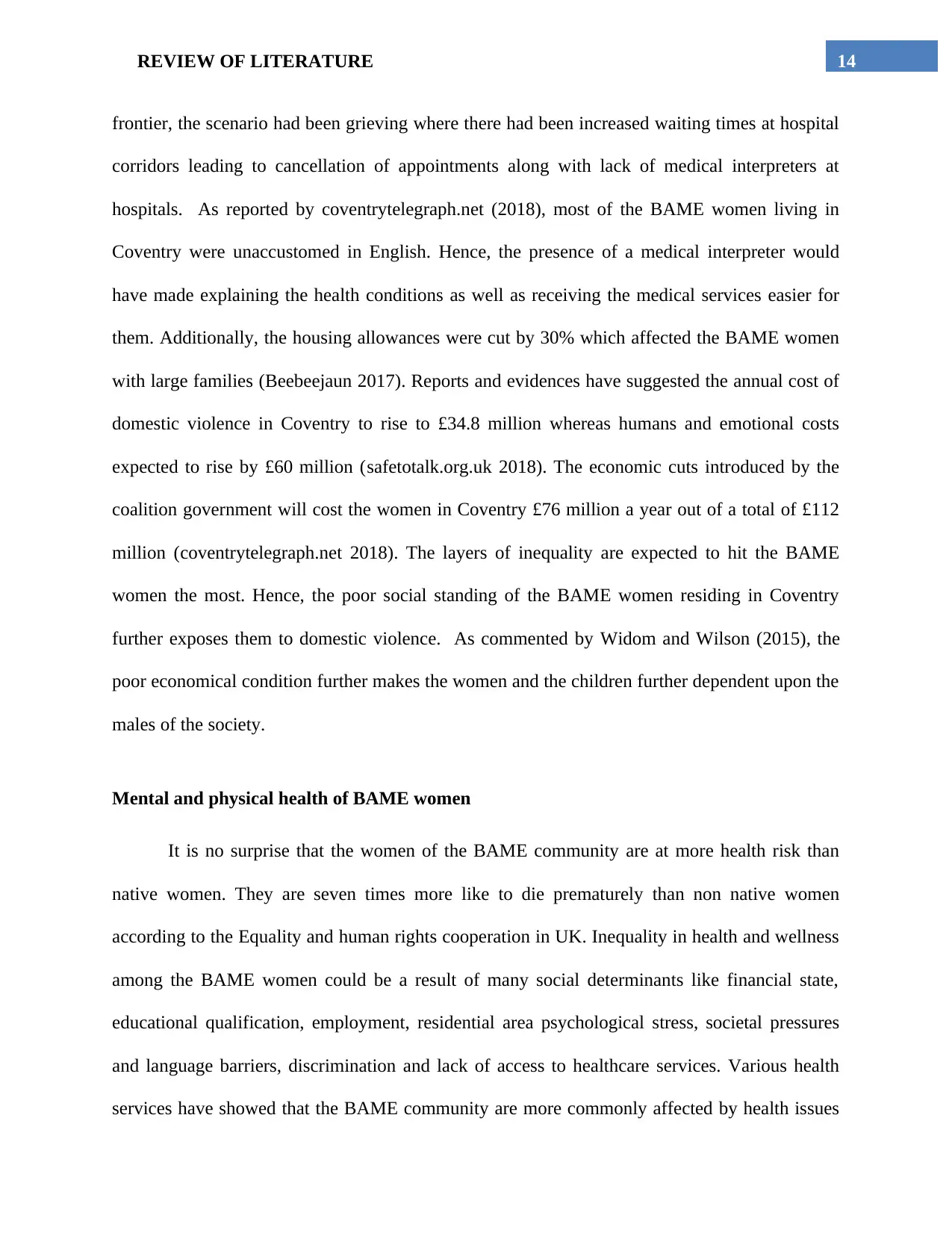
14REVIEW OF LITERATURE
frontier, the scenario had been grieving where there had been increased waiting times at hospital
corridors leading to cancellation of appointments along with lack of medical interpreters at
hospitals. As reported by coventrytelegraph.net (2018), most of the BAME women living in
Coventry were unaccustomed in English. Hence, the presence of a medical interpreter would
have made explaining the health conditions as well as receiving the medical services easier for
them. Additionally, the housing allowances were cut by 30% which affected the BAME women
with large families (Beebeejaun 2017). Reports and evidences have suggested the annual cost of
domestic violence in Coventry to rise to £34.8 million whereas humans and emotional costs
expected to rise by £60 million (safetotalk.org.uk 2018). The economic cuts introduced by the
coalition government will cost the women in Coventry £76 million a year out of a total of £112
million (coventrytelegraph.net 2018). The layers of inequality are expected to hit the BAME
women the most. Hence, the poor social standing of the BAME women residing in Coventry
further exposes them to domestic violence. As commented by Widom and Wilson (2015), the
poor economical condition further makes the women and the children further dependent upon the
males of the society.
Mental and physical health of BAME women
It is no surprise that the women of the BAME community are at more health risk than
native women. They are seven times more like to die prematurely than non native women
according to the Equality and human rights cooperation in UK. Inequality in health and wellness
among the BAME women could be a result of many social determinants like financial state,
educational qualification, employment, residential area psychological stress, societal pressures
and language barriers, discrimination and lack of access to healthcare services. Various health
services have showed that the BAME community are more commonly affected by health issues
frontier, the scenario had been grieving where there had been increased waiting times at hospital
corridors leading to cancellation of appointments along with lack of medical interpreters at
hospitals. As reported by coventrytelegraph.net (2018), most of the BAME women living in
Coventry were unaccustomed in English. Hence, the presence of a medical interpreter would
have made explaining the health conditions as well as receiving the medical services easier for
them. Additionally, the housing allowances were cut by 30% which affected the BAME women
with large families (Beebeejaun 2017). Reports and evidences have suggested the annual cost of
domestic violence in Coventry to rise to £34.8 million whereas humans and emotional costs
expected to rise by £60 million (safetotalk.org.uk 2018). The economic cuts introduced by the
coalition government will cost the women in Coventry £76 million a year out of a total of £112
million (coventrytelegraph.net 2018). The layers of inequality are expected to hit the BAME
women the most. Hence, the poor social standing of the BAME women residing in Coventry
further exposes them to domestic violence. As commented by Widom and Wilson (2015), the
poor economical condition further makes the women and the children further dependent upon the
males of the society.
Mental and physical health of BAME women
It is no surprise that the women of the BAME community are at more health risk than
native women. They are seven times more like to die prematurely than non native women
according to the Equality and human rights cooperation in UK. Inequality in health and wellness
among the BAME women could be a result of many social determinants like financial state,
educational qualification, employment, residential area psychological stress, societal pressures
and language barriers, discrimination and lack of access to healthcare services. Various health
services have showed that the BAME community are more commonly affected by health issues
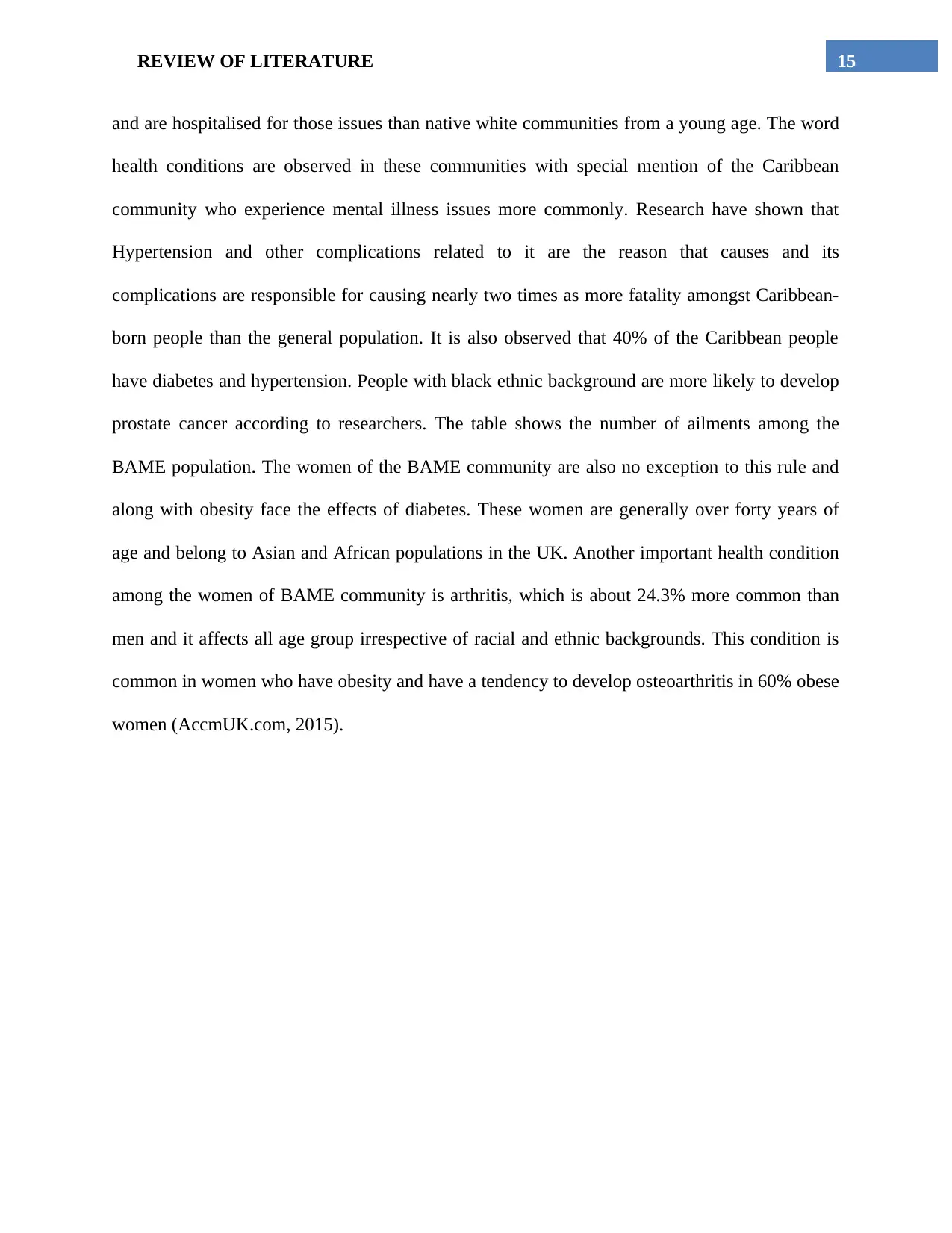
15REVIEW OF LITERATURE
and are hospitalised for those issues than native white communities from a young age. The word
health conditions are observed in these communities with special mention of the Caribbean
community who experience mental illness issues more commonly. Research have shown that
Hypertension and other complications related to it are the reason that causes and its
complications are responsible for causing nearly two times as more fatality amongst Caribbean-
born people than the general population. It is also observed that 40% of the Caribbean people
have diabetes and hypertension. People with black ethnic background are more likely to develop
prostate cancer according to researchers. The table shows the number of ailments among the
BAME population. The women of the BAME community are also no exception to this rule and
along with obesity face the effects of diabetes. These women are generally over forty years of
age and belong to Asian and African populations in the UK. Another important health condition
among the women of BAME community is arthritis, which is about 24.3% more common than
men and it affects all age group irrespective of racial and ethnic backgrounds. This condition is
common in women who have obesity and have a tendency to develop osteoarthritis in 60% obese
women (AccmUK.com, 2015).
and are hospitalised for those issues than native white communities from a young age. The word
health conditions are observed in these communities with special mention of the Caribbean
community who experience mental illness issues more commonly. Research have shown that
Hypertension and other complications related to it are the reason that causes and its
complications are responsible for causing nearly two times as more fatality amongst Caribbean-
born people than the general population. It is also observed that 40% of the Caribbean people
have diabetes and hypertension. People with black ethnic background are more likely to develop
prostate cancer according to researchers. The table shows the number of ailments among the
BAME population. The women of the BAME community are also no exception to this rule and
along with obesity face the effects of diabetes. These women are generally over forty years of
age and belong to Asian and African populations in the UK. Another important health condition
among the women of BAME community is arthritis, which is about 24.3% more common than
men and it affects all age group irrespective of racial and ethnic backgrounds. This condition is
common in women who have obesity and have a tendency to develop osteoarthritis in 60% obese
women (AccmUK.com, 2015).
Secure Best Marks with AI Grader
Need help grading? Try our AI Grader for instant feedback on your assignments.
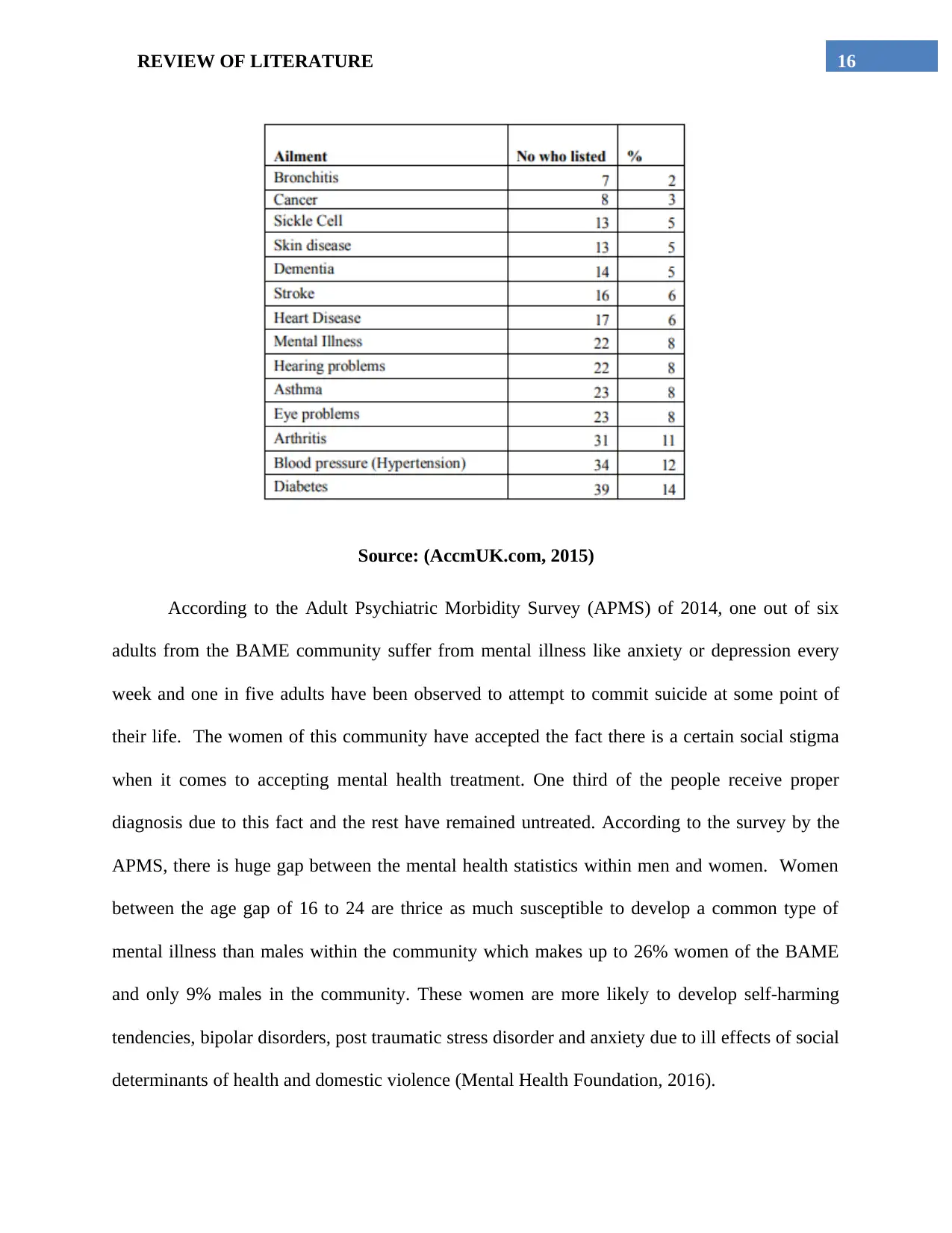
16REVIEW OF LITERATURE
Source: (AccmUK.com, 2015)
According to the Adult Psychiatric Morbidity Survey (APMS) of 2014, one out of six
adults from the BAME community suffer from mental illness like anxiety or depression every
week and one in five adults have been observed to attempt to commit suicide at some point of
their life. The women of this community have accepted the fact there is a certain social stigma
when it comes to accepting mental health treatment. One third of the people receive proper
diagnosis due to this fact and the rest have remained untreated. According to the survey by the
APMS, there is huge gap between the mental health statistics within men and women. Women
between the age gap of 16 to 24 are thrice as much susceptible to develop a common type of
mental illness than males within the community which makes up to 26% women of the BAME
and only 9% males in the community. These women are more likely to develop self-harming
tendencies, bipolar disorders, post traumatic stress disorder and anxiety due to ill effects of social
determinants of health and domestic violence (Mental Health Foundation, 2016).
Source: (AccmUK.com, 2015)
According to the Adult Psychiatric Morbidity Survey (APMS) of 2014, one out of six
adults from the BAME community suffer from mental illness like anxiety or depression every
week and one in five adults have been observed to attempt to commit suicide at some point of
their life. The women of this community have accepted the fact there is a certain social stigma
when it comes to accepting mental health treatment. One third of the people receive proper
diagnosis due to this fact and the rest have remained untreated. According to the survey by the
APMS, there is huge gap between the mental health statistics within men and women. Women
between the age gap of 16 to 24 are thrice as much susceptible to develop a common type of
mental illness than males within the community which makes up to 26% women of the BAME
and only 9% males in the community. These women are more likely to develop self-harming
tendencies, bipolar disorders, post traumatic stress disorder and anxiety due to ill effects of social
determinants of health and domestic violence (Mental Health Foundation, 2016).
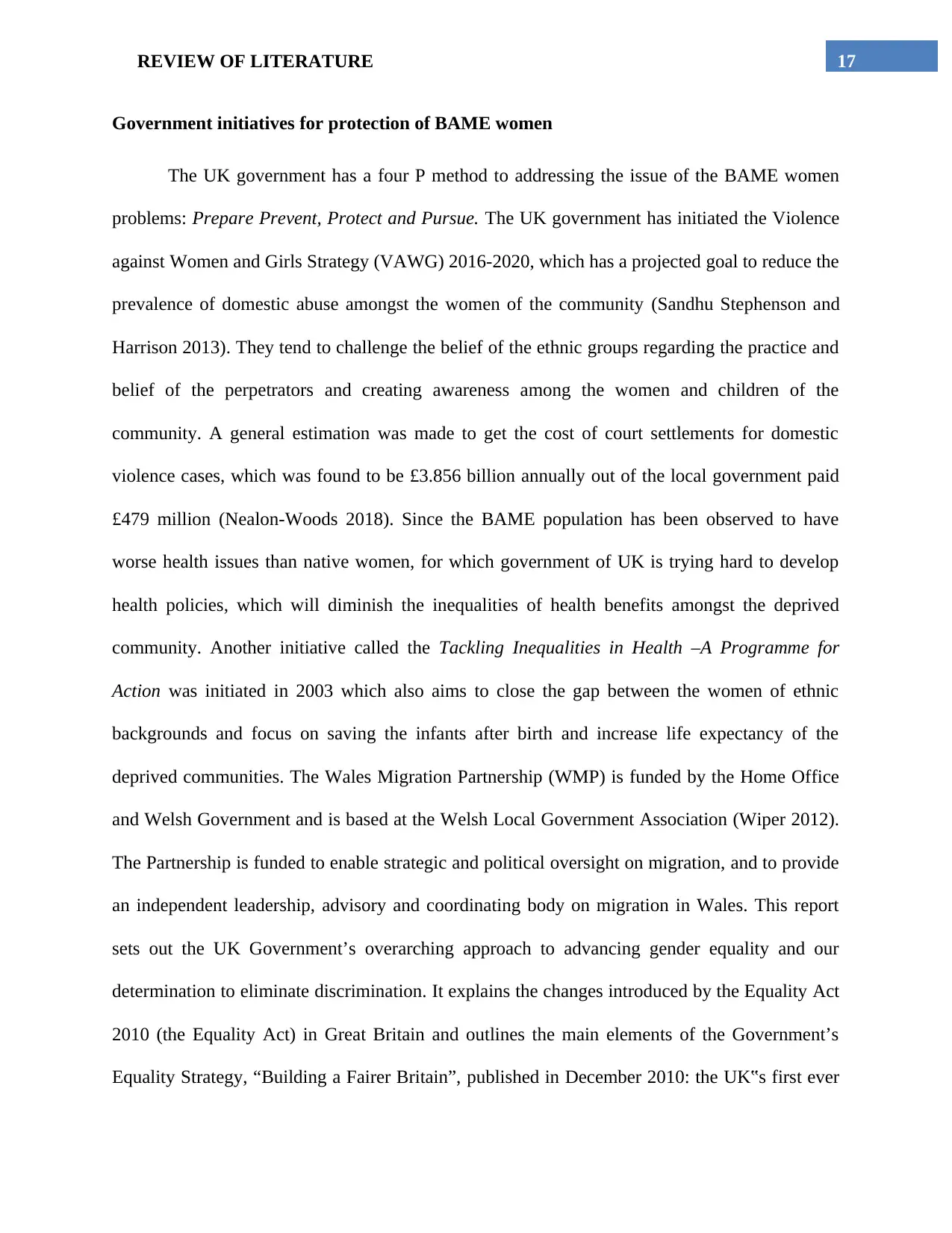
17REVIEW OF LITERATURE
Government initiatives for protection of BAME women
The UK government has a four P method to addressing the issue of the BAME women
problems: Prepare Prevent, Protect and Pursue. The UK government has initiated the Violence
against Women and Girls Strategy (VAWG) 2016-2020, which has a projected goal to reduce the
prevalence of domestic abuse amongst the women of the community (Sandhu Stephenson and
Harrison 2013). They tend to challenge the belief of the ethnic groups regarding the practice and
belief of the perpetrators and creating awareness among the women and children of the
community. A general estimation was made to get the cost of court settlements for domestic
violence cases, which was found to be £3.856 billion annually out of the local government paid
£479 million (Nealon-Woods 2018). Since the BAME population has been observed to have
worse health issues than native women, for which government of UK is trying hard to develop
health policies, which will diminish the inequalities of health benefits amongst the deprived
community. Another initiative called the Tackling Inequalities in Health –A Programme for
Action was initiated in 2003 which also aims to close the gap between the women of ethnic
backgrounds and focus on saving the infants after birth and increase life expectancy of the
deprived communities. The Wales Migration Partnership (WMP) is funded by the Home Office
and Welsh Government and is based at the Welsh Local Government Association (Wiper 2012).
The Partnership is funded to enable strategic and political oversight on migration, and to provide
an independent leadership, advisory and coordinating body on migration in Wales. This report
sets out the UK Government’s overarching approach to advancing gender equality and our
determination to eliminate discrimination. It explains the changes introduced by the Equality Act
2010 (the Equality Act) in Great Britain and outlines the main elements of the Government’s
Equality Strategy, “Building a Fairer Britain”, published in December 2010: the UK‟s first ever
Government initiatives for protection of BAME women
The UK government has a four P method to addressing the issue of the BAME women
problems: Prepare Prevent, Protect and Pursue. The UK government has initiated the Violence
against Women and Girls Strategy (VAWG) 2016-2020, which has a projected goal to reduce the
prevalence of domestic abuse amongst the women of the community (Sandhu Stephenson and
Harrison 2013). They tend to challenge the belief of the ethnic groups regarding the practice and
belief of the perpetrators and creating awareness among the women and children of the
community. A general estimation was made to get the cost of court settlements for domestic
violence cases, which was found to be £3.856 billion annually out of the local government paid
£479 million (Nealon-Woods 2018). Since the BAME population has been observed to have
worse health issues than native women, for which government of UK is trying hard to develop
health policies, which will diminish the inequalities of health benefits amongst the deprived
community. Another initiative called the Tackling Inequalities in Health –A Programme for
Action was initiated in 2003 which also aims to close the gap between the women of ethnic
backgrounds and focus on saving the infants after birth and increase life expectancy of the
deprived communities. The Wales Migration Partnership (WMP) is funded by the Home Office
and Welsh Government and is based at the Welsh Local Government Association (Wiper 2012).
The Partnership is funded to enable strategic and political oversight on migration, and to provide
an independent leadership, advisory and coordinating body on migration in Wales. This report
sets out the UK Government’s overarching approach to advancing gender equality and our
determination to eliminate discrimination. It explains the changes introduced by the Equality Act
2010 (the Equality Act) in Great Britain and outlines the main elements of the Government’s
Equality Strategy, “Building a Fairer Britain”, published in December 2010: the UK‟s first ever
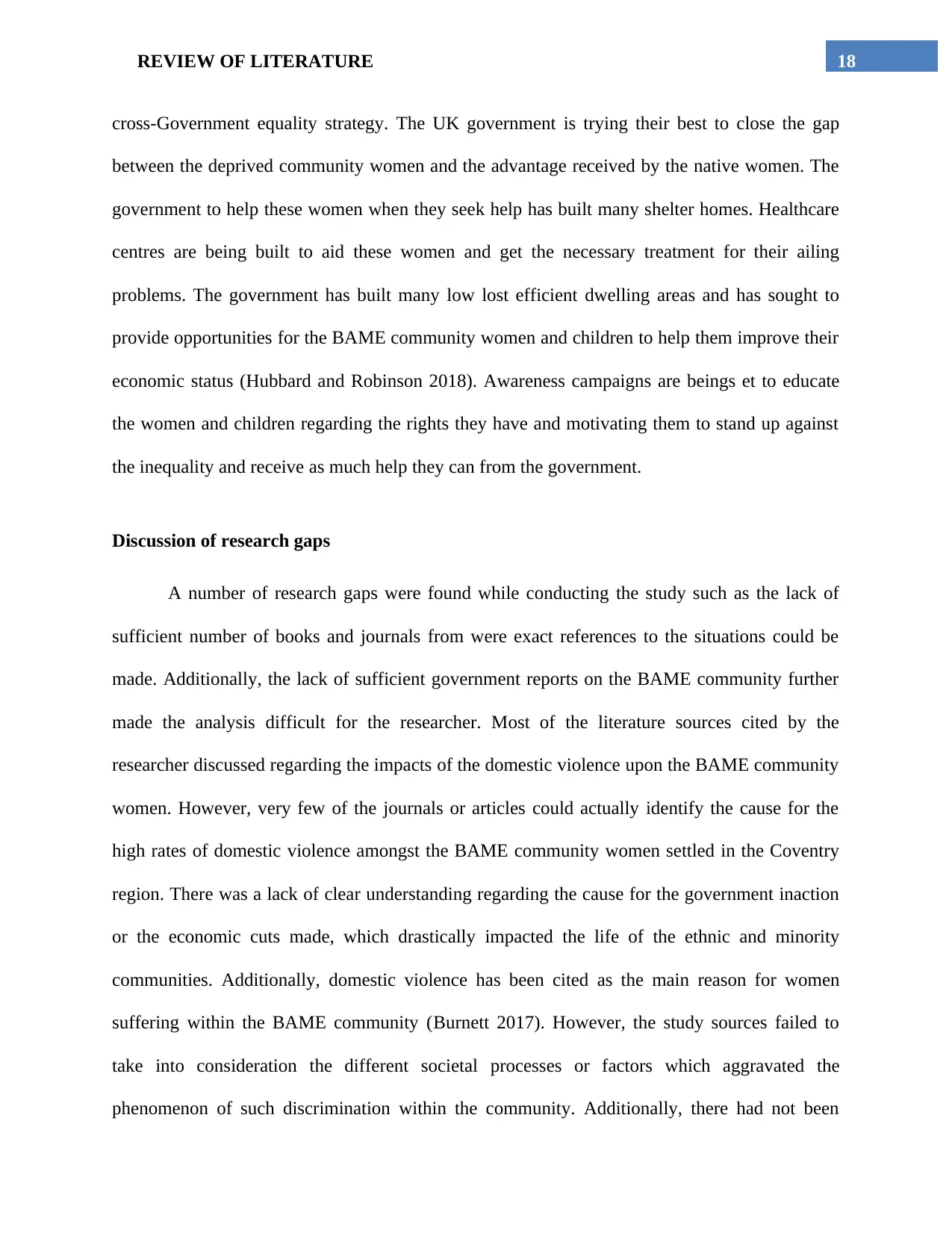
18REVIEW OF LITERATURE
cross-Government equality strategy. The UK government is trying their best to close the gap
between the deprived community women and the advantage received by the native women. The
government to help these women when they seek help has built many shelter homes. Healthcare
centres are being built to aid these women and get the necessary treatment for their ailing
problems. The government has built many low lost efficient dwelling areas and has sought to
provide opportunities for the BAME community women and children to help them improve their
economic status (Hubbard and Robinson 2018). Awareness campaigns are beings et to educate
the women and children regarding the rights they have and motivating them to stand up against
the inequality and receive as much help they can from the government.
Discussion of research gaps
A number of research gaps were found while conducting the study such as the lack of
sufficient number of books and journals from were exact references to the situations could be
made. Additionally, the lack of sufficient government reports on the BAME community further
made the analysis difficult for the researcher. Most of the literature sources cited by the
researcher discussed regarding the impacts of the domestic violence upon the BAME community
women. However, very few of the journals or articles could actually identify the cause for the
high rates of domestic violence amongst the BAME community women settled in the Coventry
region. There was a lack of clear understanding regarding the cause for the government inaction
or the economic cuts made, which drastically impacted the life of the ethnic and minority
communities. Additionally, domestic violence has been cited as the main reason for women
suffering within the BAME community (Burnett 2017). However, the study sources failed to
take into consideration the different societal processes or factors which aggravated the
phenomenon of such discrimination within the community. Additionally, there had not been
cross-Government equality strategy. The UK government is trying their best to close the gap
between the deprived community women and the advantage received by the native women. The
government to help these women when they seek help has built many shelter homes. Healthcare
centres are being built to aid these women and get the necessary treatment for their ailing
problems. The government has built many low lost efficient dwelling areas and has sought to
provide opportunities for the BAME community women and children to help them improve their
economic status (Hubbard and Robinson 2018). Awareness campaigns are beings et to educate
the women and children regarding the rights they have and motivating them to stand up against
the inequality and receive as much help they can from the government.
Discussion of research gaps
A number of research gaps were found while conducting the study such as the lack of
sufficient number of books and journals from were exact references to the situations could be
made. Additionally, the lack of sufficient government reports on the BAME community further
made the analysis difficult for the researcher. Most of the literature sources cited by the
researcher discussed regarding the impacts of the domestic violence upon the BAME community
women. However, very few of the journals or articles could actually identify the cause for the
high rates of domestic violence amongst the BAME community women settled in the Coventry
region. There was a lack of clear understanding regarding the cause for the government inaction
or the economic cuts made, which drastically impacted the life of the ethnic and minority
communities. Additionally, domestic violence has been cited as the main reason for women
suffering within the BAME community (Burnett 2017). However, the study sources failed to
take into consideration the different societal processes or factors which aggravated the
phenomenon of such discrimination within the community. Additionally, there had not been
Paraphrase This Document
Need a fresh take? Get an instant paraphrase of this document with our AI Paraphraser
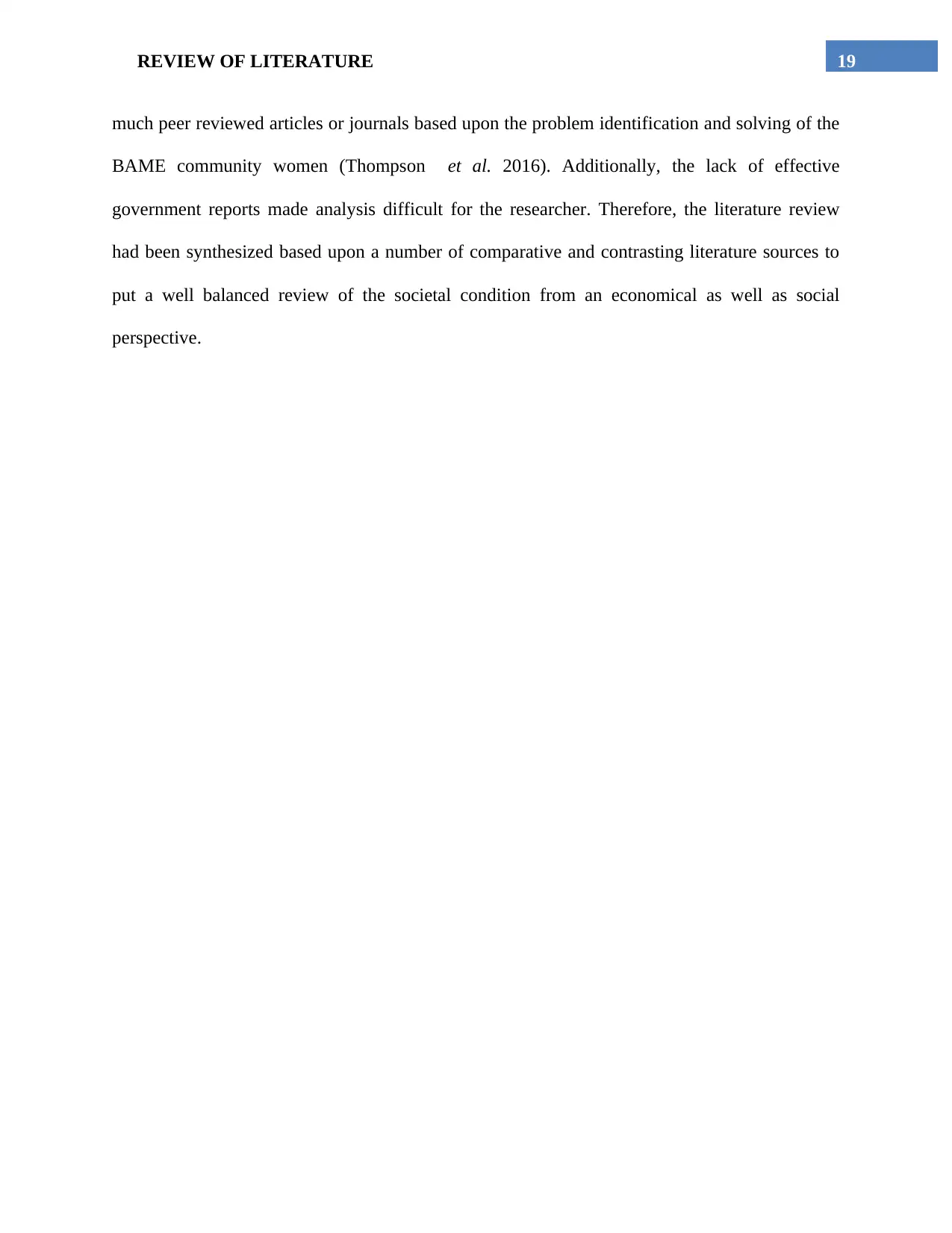
19REVIEW OF LITERATURE
much peer reviewed articles or journals based upon the problem identification and solving of the
BAME community women (Thompson et al. 2016). Additionally, the lack of effective
government reports made analysis difficult for the researcher. Therefore, the literature review
had been synthesized based upon a number of comparative and contrasting literature sources to
put a well balanced review of the societal condition from an economical as well as social
perspective.
much peer reviewed articles or journals based upon the problem identification and solving of the
BAME community women (Thompson et al. 2016). Additionally, the lack of effective
government reports made analysis difficult for the researcher. Therefore, the literature review
had been synthesized based upon a number of comparative and contrasting literature sources to
put a well balanced review of the societal condition from an economical as well as social
perspective.

20REVIEW OF LITERATURE
Conclusion
The literature makes it clear that there is morbid inequality in the rights of women from
the Black, Asian, Minority and Ethnic background women, and has been so for the past hundred
years. Social determinants of health have deprived these women from the basic livelihood
requirements and made them susceptible to domestic violence. Financial inequality, racial
discrimination, education impairment, perceptive morality amongst ethnic groups has oppressed
these women, which has caused them various mental and physical health issues. The physical
issues because of domestic violence are susceptibility to obesity, diabetes, hypertension and
arthritis. The mental health issues which come as a consequence of domestic violence are post
traumatic stress disorder, anxiety, hypertension, depression, low self esteem etc. Many women
have succumbed to self-harm and sought after suicidal tendencies. The children of these families
witness the acts of violence, which tend to scar them for life, leaving them with depression, lack
of concentration, fear and by the time they reach adolescence, they are more likely to succumb to
drug abuse. The government is trying their best to help these women overcome their mental and
physical well-being and setting up healthcare facilities, developing legislative regulations and
policies to grant them the rights of humanity. Welfare organizations also play an important role
in taking a step into the betterment of the lives of BAME women, and help these women shelter
and other necessities.
Conclusion
The literature makes it clear that there is morbid inequality in the rights of women from
the Black, Asian, Minority and Ethnic background women, and has been so for the past hundred
years. Social determinants of health have deprived these women from the basic livelihood
requirements and made them susceptible to domestic violence. Financial inequality, racial
discrimination, education impairment, perceptive morality amongst ethnic groups has oppressed
these women, which has caused them various mental and physical health issues. The physical
issues because of domestic violence are susceptibility to obesity, diabetes, hypertension and
arthritis. The mental health issues which come as a consequence of domestic violence are post
traumatic stress disorder, anxiety, hypertension, depression, low self esteem etc. Many women
have succumbed to self-harm and sought after suicidal tendencies. The children of these families
witness the acts of violence, which tend to scar them for life, leaving them with depression, lack
of concentration, fear and by the time they reach adolescence, they are more likely to succumb to
drug abuse. The government is trying their best to help these women overcome their mental and
physical well-being and setting up healthcare facilities, developing legislative regulations and
policies to grant them the rights of humanity. Welfare organizations also play an important role
in taking a step into the betterment of the lives of BAME women, and help these women shelter
and other necessities.
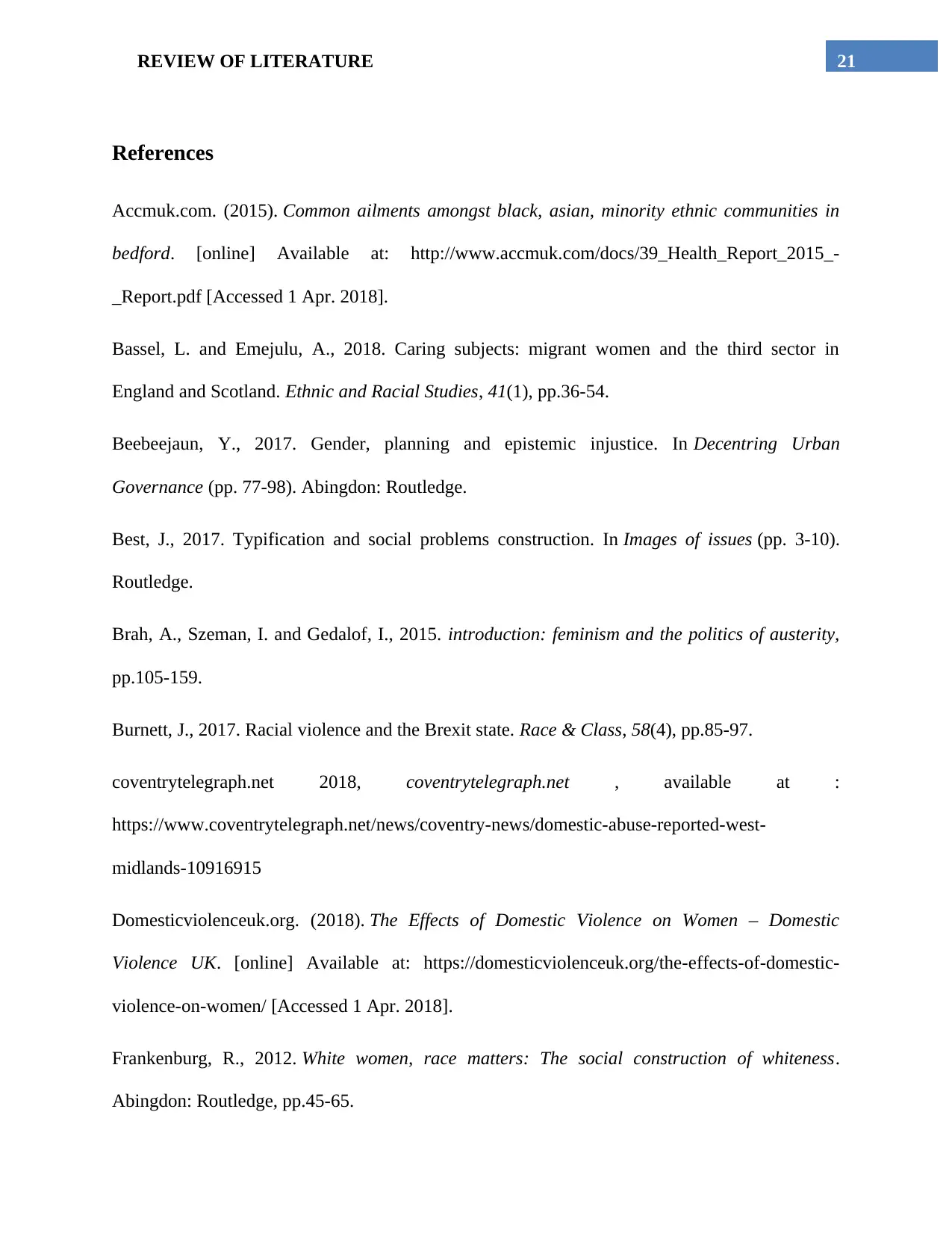
21REVIEW OF LITERATURE
References
Accmuk.com. (2015). Common ailments amongst black, asian, minority ethnic communities in
bedford. [online] Available at: http://www.accmuk.com/docs/39_Health_Report_2015_-
_Report.pdf [Accessed 1 Apr. 2018].
Bassel, L. and Emejulu, A., 2018. Caring subjects: migrant women and the third sector in
England and Scotland. Ethnic and Racial Studies, 41(1), pp.36-54.
Beebeejaun, Y., 2017. Gender, planning and epistemic injustice. In Decentring Urban
Governance (pp. 77-98). Abingdon: Routledge.
Best, J., 2017. Typification and social problems construction. In Images of issues (pp. 3-10).
Routledge.
Brah, A., Szeman, I. and Gedalof, I., 2015. introduction: feminism and the politics of austerity,
pp.105-159.
Burnett, J., 2017. Racial violence and the Brexit state. Race & Class, 58(4), pp.85-97.
coventrytelegraph.net 2018, coventrytelegraph.net , available at :
https://www.coventrytelegraph.net/news/coventry-news/domestic-abuse-reported-west-
midlands-10916915
Domesticviolenceuk.org. (2018). The Effects of Domestic Violence on Women – Domestic
Violence UK. [online] Available at: https://domesticviolenceuk.org/the-effects-of-domestic-
violence-on-women/ [Accessed 1 Apr. 2018].
Frankenburg, R., 2012. White women, race matters: The social construction of whiteness.
Abingdon: Routledge, pp.45-65.
References
Accmuk.com. (2015). Common ailments amongst black, asian, minority ethnic communities in
bedford. [online] Available at: http://www.accmuk.com/docs/39_Health_Report_2015_-
_Report.pdf [Accessed 1 Apr. 2018].
Bassel, L. and Emejulu, A., 2018. Caring subjects: migrant women and the third sector in
England and Scotland. Ethnic and Racial Studies, 41(1), pp.36-54.
Beebeejaun, Y., 2017. Gender, planning and epistemic injustice. In Decentring Urban
Governance (pp. 77-98). Abingdon: Routledge.
Best, J., 2017. Typification and social problems construction. In Images of issues (pp. 3-10).
Routledge.
Brah, A., Szeman, I. and Gedalof, I., 2015. introduction: feminism and the politics of austerity,
pp.105-159.
Burnett, J., 2017. Racial violence and the Brexit state. Race & Class, 58(4), pp.85-97.
coventrytelegraph.net 2018, coventrytelegraph.net , available at :
https://www.coventrytelegraph.net/news/coventry-news/domestic-abuse-reported-west-
midlands-10916915
Domesticviolenceuk.org. (2018). The Effects of Domestic Violence on Women – Domestic
Violence UK. [online] Available at: https://domesticviolenceuk.org/the-effects-of-domestic-
violence-on-women/ [Accessed 1 Apr. 2018].
Frankenburg, R., 2012. White women, race matters: The social construction of whiteness.
Abingdon: Routledge, pp.45-65.
Secure Best Marks with AI Grader
Need help grading? Try our AI Grader for instant feedback on your assignments.
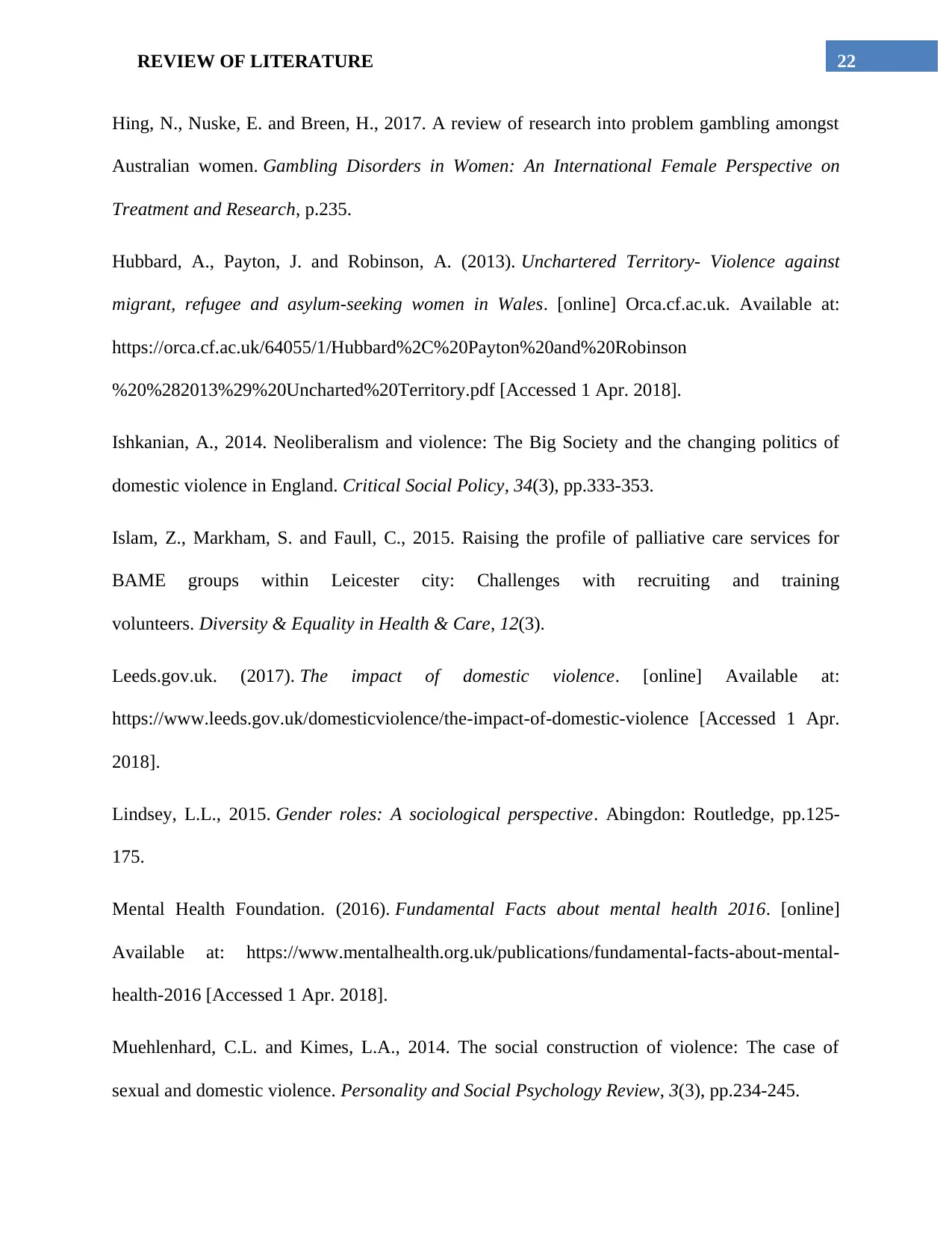
22REVIEW OF LITERATURE
Hing, N., Nuske, E. and Breen, H., 2017. A review of research into problem gambling amongst
Australian women. Gambling Disorders in Women: An International Female Perspective on
Treatment and Research, p.235.
Hubbard, A., Payton, J. and Robinson, A. (2013). Unchartered Territory- Violence against
migrant, refugee and asylum-seeking women in Wales. [online] Orca.cf.ac.uk. Available at:
https://orca.cf.ac.uk/64055/1/Hubbard%2C%20Payton%20and%20Robinson
%20%282013%29%20Uncharted%20Territory.pdf [Accessed 1 Apr. 2018].
Ishkanian, A., 2014. Neoliberalism and violence: The Big Society and the changing politics of
domestic violence in England. Critical Social Policy, 34(3), pp.333-353.
Islam, Z., Markham, S. and Faull, C., 2015. Raising the profile of palliative care services for
BAME groups within Leicester city: Challenges with recruiting and training
volunteers. Diversity & Equality in Health & Care, 12(3).
Leeds.gov.uk. (2017). The impact of domestic violence. [online] Available at:
https://www.leeds.gov.uk/domesticviolence/the-impact-of-domestic-violence [Accessed 1 Apr.
2018].
Lindsey, L.L., 2015. Gender roles: A sociological perspective. Abingdon: Routledge, pp.125-
175.
Mental Health Foundation. (2016). Fundamental Facts about mental health 2016. [online]
Available at: https://www.mentalhealth.org.uk/publications/fundamental-facts-about-mental-
health-2016 [Accessed 1 Apr. 2018].
Muehlenhard, C.L. and Kimes, L.A., 2014. The social construction of violence: The case of
sexual and domestic violence. Personality and Social Psychology Review, 3(3), pp.234-245.
Hing, N., Nuske, E. and Breen, H., 2017. A review of research into problem gambling amongst
Australian women. Gambling Disorders in Women: An International Female Perspective on
Treatment and Research, p.235.
Hubbard, A., Payton, J. and Robinson, A. (2013). Unchartered Territory- Violence against
migrant, refugee and asylum-seeking women in Wales. [online] Orca.cf.ac.uk. Available at:
https://orca.cf.ac.uk/64055/1/Hubbard%2C%20Payton%20and%20Robinson
%20%282013%29%20Uncharted%20Territory.pdf [Accessed 1 Apr. 2018].
Ishkanian, A., 2014. Neoliberalism and violence: The Big Society and the changing politics of
domestic violence in England. Critical Social Policy, 34(3), pp.333-353.
Islam, Z., Markham, S. and Faull, C., 2015. Raising the profile of palliative care services for
BAME groups within Leicester city: Challenges with recruiting and training
volunteers. Diversity & Equality in Health & Care, 12(3).
Leeds.gov.uk. (2017). The impact of domestic violence. [online] Available at:
https://www.leeds.gov.uk/domesticviolence/the-impact-of-domestic-violence [Accessed 1 Apr.
2018].
Lindsey, L.L., 2015. Gender roles: A sociological perspective. Abingdon: Routledge, pp.125-
175.
Mental Health Foundation. (2016). Fundamental Facts about mental health 2016. [online]
Available at: https://www.mentalhealth.org.uk/publications/fundamental-facts-about-mental-
health-2016 [Accessed 1 Apr. 2018].
Muehlenhard, C.L. and Kimes, L.A., 2014. The social construction of violence: The case of
sexual and domestic violence. Personality and Social Psychology Review, 3(3), pp.234-245.
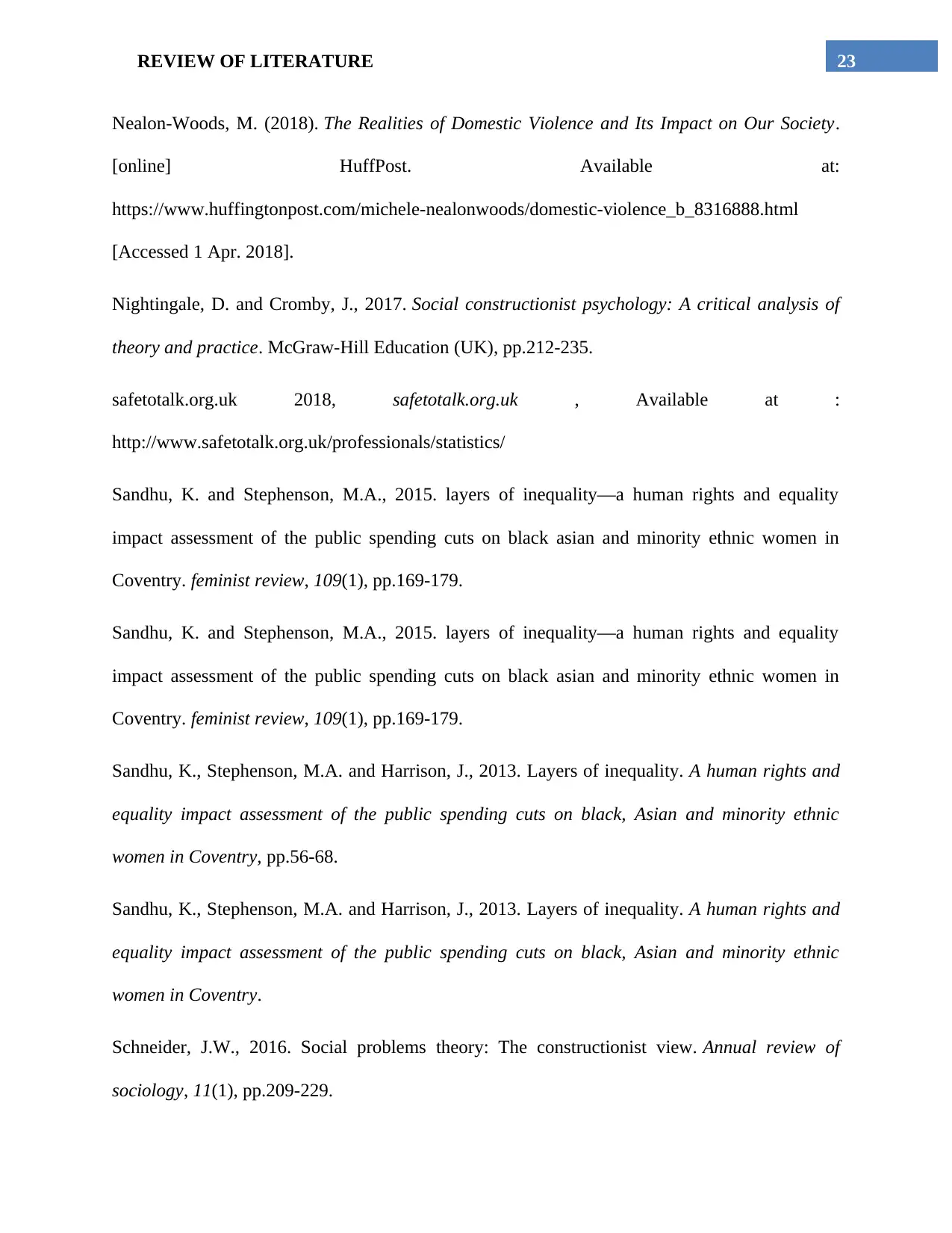
23REVIEW OF LITERATURE
Nealon-Woods, M. (2018). The Realities of Domestic Violence and Its Impact on Our Society.
[online] HuffPost. Available at:
https://www.huffingtonpost.com/michele-nealonwoods/domestic-violence_b_8316888.html
[Accessed 1 Apr. 2018].
Nightingale, D. and Cromby, J., 2017. Social constructionist psychology: A critical analysis of
theory and practice. McGraw-Hill Education (UK), pp.212-235.
safetotalk.org.uk 2018, safetotalk.org.uk , Available at :
http://www.safetotalk.org.uk/professionals/statistics/
Sandhu, K. and Stephenson, M.A., 2015. layers of inequality—a human rights and equality
impact assessment of the public spending cuts on black asian and minority ethnic women in
Coventry. feminist review, 109(1), pp.169-179.
Sandhu, K. and Stephenson, M.A., 2015. layers of inequality—a human rights and equality
impact assessment of the public spending cuts on black asian and minority ethnic women in
Coventry. feminist review, 109(1), pp.169-179.
Sandhu, K., Stephenson, M.A. and Harrison, J., 2013. Layers of inequality. A human rights and
equality impact assessment of the public spending cuts on black, Asian and minority ethnic
women in Coventry, pp.56-68.
Sandhu, K., Stephenson, M.A. and Harrison, J., 2013. Layers of inequality. A human rights and
equality impact assessment of the public spending cuts on black, Asian and minority ethnic
women in Coventry.
Schneider, J.W., 2016. Social problems theory: The constructionist view. Annual review of
sociology, 11(1), pp.209-229.
Nealon-Woods, M. (2018). The Realities of Domestic Violence and Its Impact on Our Society.
[online] HuffPost. Available at:
https://www.huffingtonpost.com/michele-nealonwoods/domestic-violence_b_8316888.html
[Accessed 1 Apr. 2018].
Nightingale, D. and Cromby, J., 2017. Social constructionist psychology: A critical analysis of
theory and practice. McGraw-Hill Education (UK), pp.212-235.
safetotalk.org.uk 2018, safetotalk.org.uk , Available at :
http://www.safetotalk.org.uk/professionals/statistics/
Sandhu, K. and Stephenson, M.A., 2015. layers of inequality—a human rights and equality
impact assessment of the public spending cuts on black asian and minority ethnic women in
Coventry. feminist review, 109(1), pp.169-179.
Sandhu, K. and Stephenson, M.A., 2015. layers of inequality—a human rights and equality
impact assessment of the public spending cuts on black asian and minority ethnic women in
Coventry. feminist review, 109(1), pp.169-179.
Sandhu, K., Stephenson, M.A. and Harrison, J., 2013. Layers of inequality. A human rights and
equality impact assessment of the public spending cuts on black, Asian and minority ethnic
women in Coventry, pp.56-68.
Sandhu, K., Stephenson, M.A. and Harrison, J., 2013. Layers of inequality. A human rights and
equality impact assessment of the public spending cuts on black, Asian and minority ethnic
women in Coventry.
Schneider, J.W., 2016. Social problems theory: The constructionist view. Annual review of
sociology, 11(1), pp.209-229.
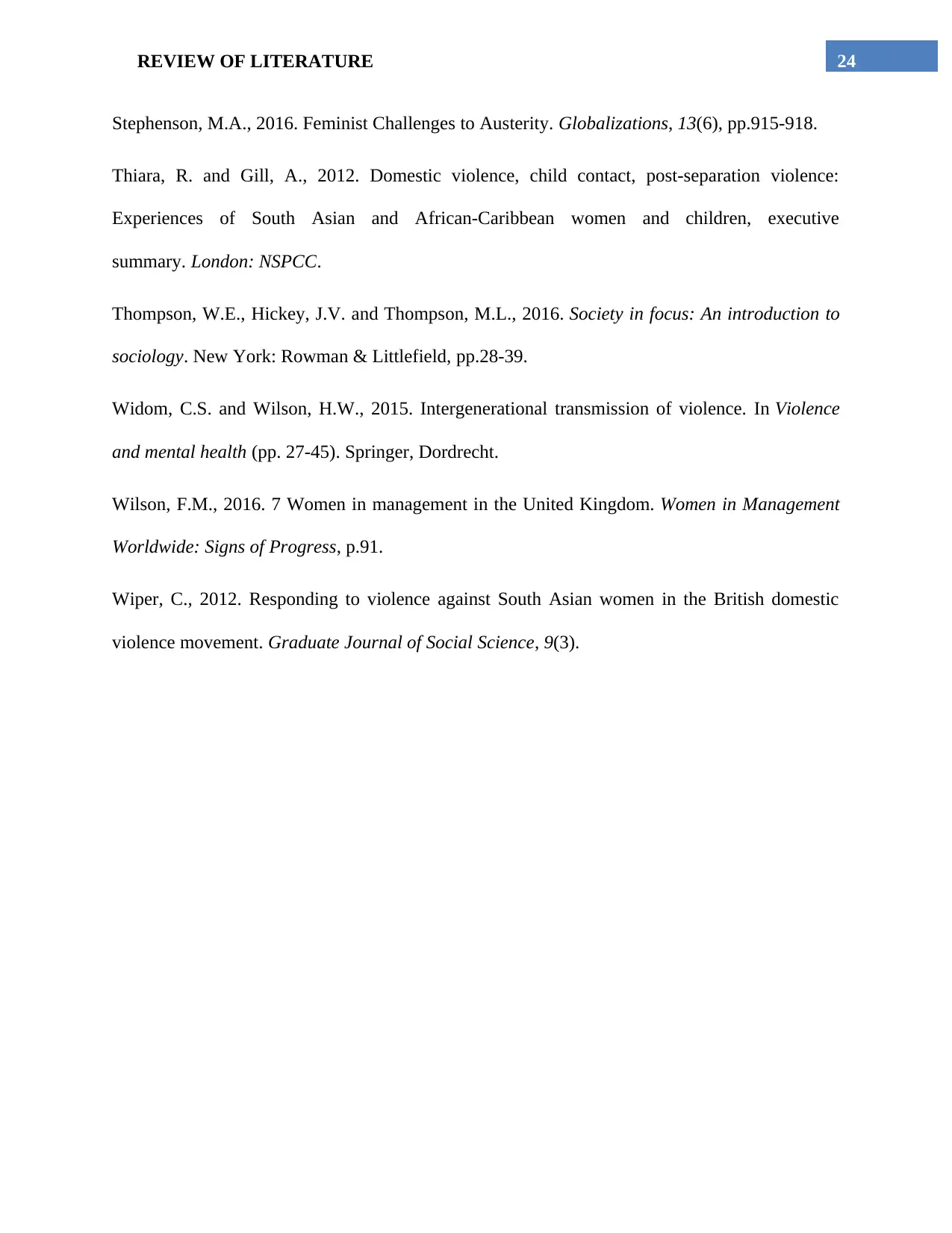
24REVIEW OF LITERATURE
Stephenson, M.A., 2016. Feminist Challenges to Austerity. Globalizations, 13(6), pp.915-918.
Thiara, R. and Gill, A., 2012. Domestic violence, child contact, post-separation violence:
Experiences of South Asian and African-Caribbean women and children, executive
summary. London: NSPCC.
Thompson, W.E., Hickey, J.V. and Thompson, M.L., 2016. Society in focus: An introduction to
sociology. New York: Rowman & Littlefield, pp.28-39.
Widom, C.S. and Wilson, H.W., 2015. Intergenerational transmission of violence. In Violence
and mental health (pp. 27-45). Springer, Dordrecht.
Wilson, F.M., 2016. 7 Women in management in the United Kingdom. Women in Management
Worldwide: Signs of Progress, p.91.
Wiper, C., 2012. Responding to violence against South Asian women in the British domestic
violence movement. Graduate Journal of Social Science, 9(3).
Stephenson, M.A., 2016. Feminist Challenges to Austerity. Globalizations, 13(6), pp.915-918.
Thiara, R. and Gill, A., 2012. Domestic violence, child contact, post-separation violence:
Experiences of South Asian and African-Caribbean women and children, executive
summary. London: NSPCC.
Thompson, W.E., Hickey, J.V. and Thompson, M.L., 2016. Society in focus: An introduction to
sociology. New York: Rowman & Littlefield, pp.28-39.
Widom, C.S. and Wilson, H.W., 2015. Intergenerational transmission of violence. In Violence
and mental health (pp. 27-45). Springer, Dordrecht.
Wilson, F.M., 2016. 7 Women in management in the United Kingdom. Women in Management
Worldwide: Signs of Progress, p.91.
Wiper, C., 2012. Responding to violence against South Asian women in the British domestic
violence movement. Graduate Journal of Social Science, 9(3).
1 out of 25
Related Documents
Your All-in-One AI-Powered Toolkit for Academic Success.
+13062052269
info@desklib.com
Available 24*7 on WhatsApp / Email
![[object Object]](/_next/static/media/star-bottom.7253800d.svg)
Unlock your academic potential
© 2024 | Zucol Services PVT LTD | All rights reserved.




